

Discover more from Real Gaijin
Don’t Be “That Guy” at a Japanese Hot Spring or Public Bath
While most of the rules for bathing at an onsen or sento in Japan are common sense, a rudimentary understanding of the signs will enhance the experience.
What’s new: As Japan welcomes record numbers of foreign visitors, after enduring long lines at the most popular tourist attractions, many travelers have decided to shed their inhibitions and seek relaxation by trying the quintessential Japanese form of relaxation, a hot spring or onsen (温泉).
There are many detailed accounts on the Internet - including the Real Gaijin archives - of what to expect when visiting an onsen. See "Barbeque. Chicken. Alert! …from Way Down South in Japan: Head to the Tororo-no-Yu Onsen Hot Spring for a Delicious DYI Meal and Bath" for a first-hand account. Read "News Flash: Japanese Onsen Hot Springs Are Good for Your Health! A growing body of clinical evidence is being used to prove the positive effects and health benefits of hot springs, called onsen in Japanese," to see why no visit to Japan is complete without a trip to an onsen.
Alternatively, you can visit a public bath called a sento (銭湯) in a city, but the experience will probably pale in comparison to a true hot spring in the countryside.
Yes, but: What do all these signs mean?
No need to worry! After familiarizing yourself with the most common Japanese vocabulary related to onsen and sento, you will be ready to jump in (without making a splash).
First, you need to find a place to take a bath. Look for the Kanji character yu (湯), which means "hot water" and may be written simply as ゆ in hiragana.
You may also find the universally recognized symbol for public baths and hot springs (♨). This is not a real Kanji character, but everyone in Japan knows it.
Once you find a place to take a bath, it is good to remember the proper etiquette. Over several millennia, the Japanese have developed a society based on a detailed network of rules and regulations. These principles also apply to bathing. Thus, any visit to a hot spring requires a prior understanding of the do's and don'ts of proper etiquette. Remember that we foreigners, or gaijin (外人), are visitors, and therefore the Japanese saying "go ni ireba, go ni shitagae" (郷に入れば郷に従え), which essentially means "when in Rome, do as the Romans do," applies. Just as the Romans bathed, the Japanese bathe naked. So, before you potentially commit a major fax paus in the bath, take a little time to familiarize yourself with some of the signage you are likely to encounter during any visit to an onsen or sento.
While I may have missed a few, the following list should be enough to keep you out of hot water (although that’s the intended destination) or an embarrassing situation.
Use the Proper Entrance
This first piece of advice may seem pretty basic, but it is always a good idea to double-check that you have selected the correct entry.
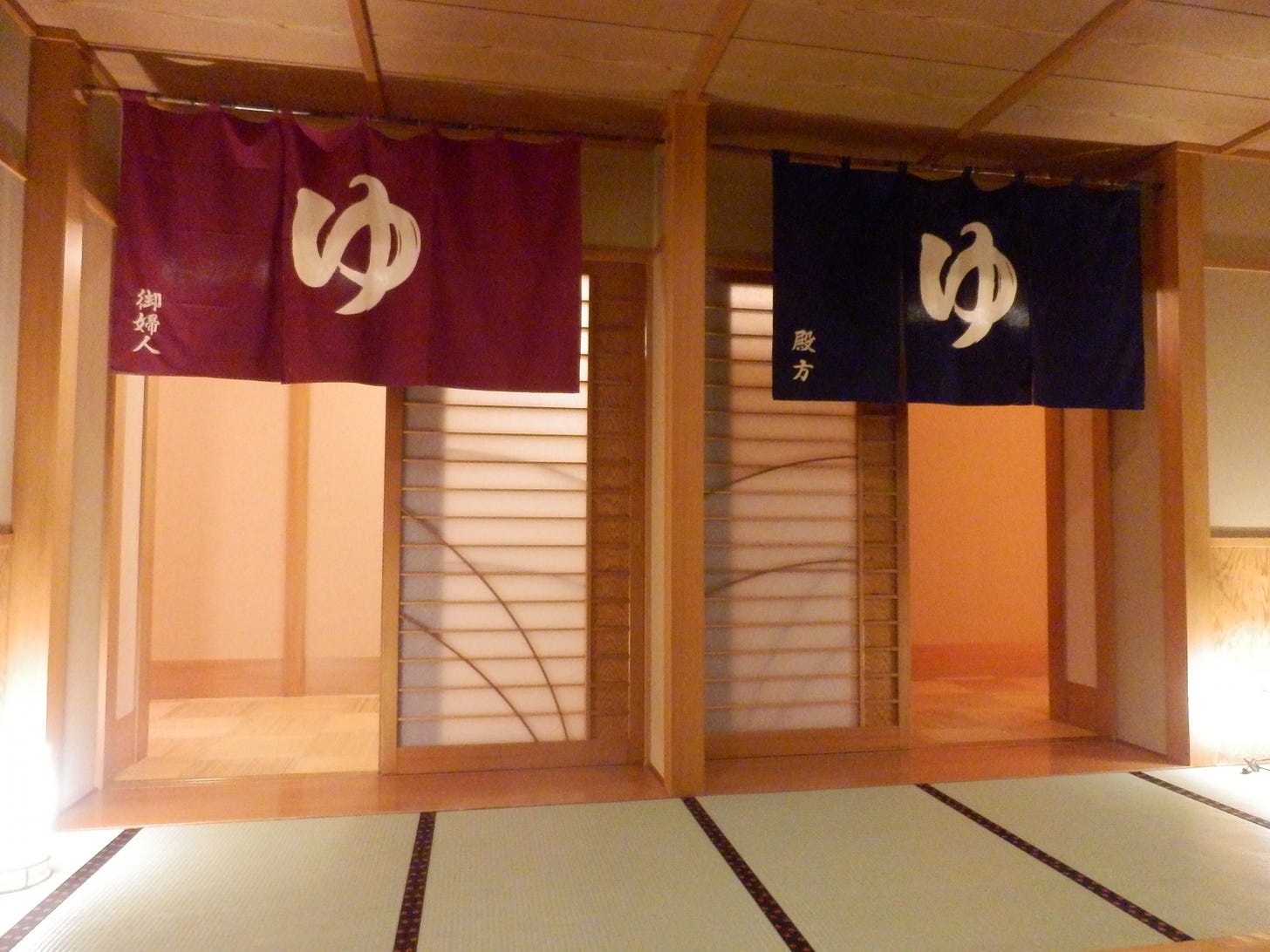
Except for a few communal mixed bathing facilities called konyoku (混浴) scattered throughout the country, most onsen and sento are gender-specific. Especially since many hot spring resorts designate one bath for women and another for men on certain days of the week (e.g., every other day), you should first make sure that you enter the correct bath before changing.
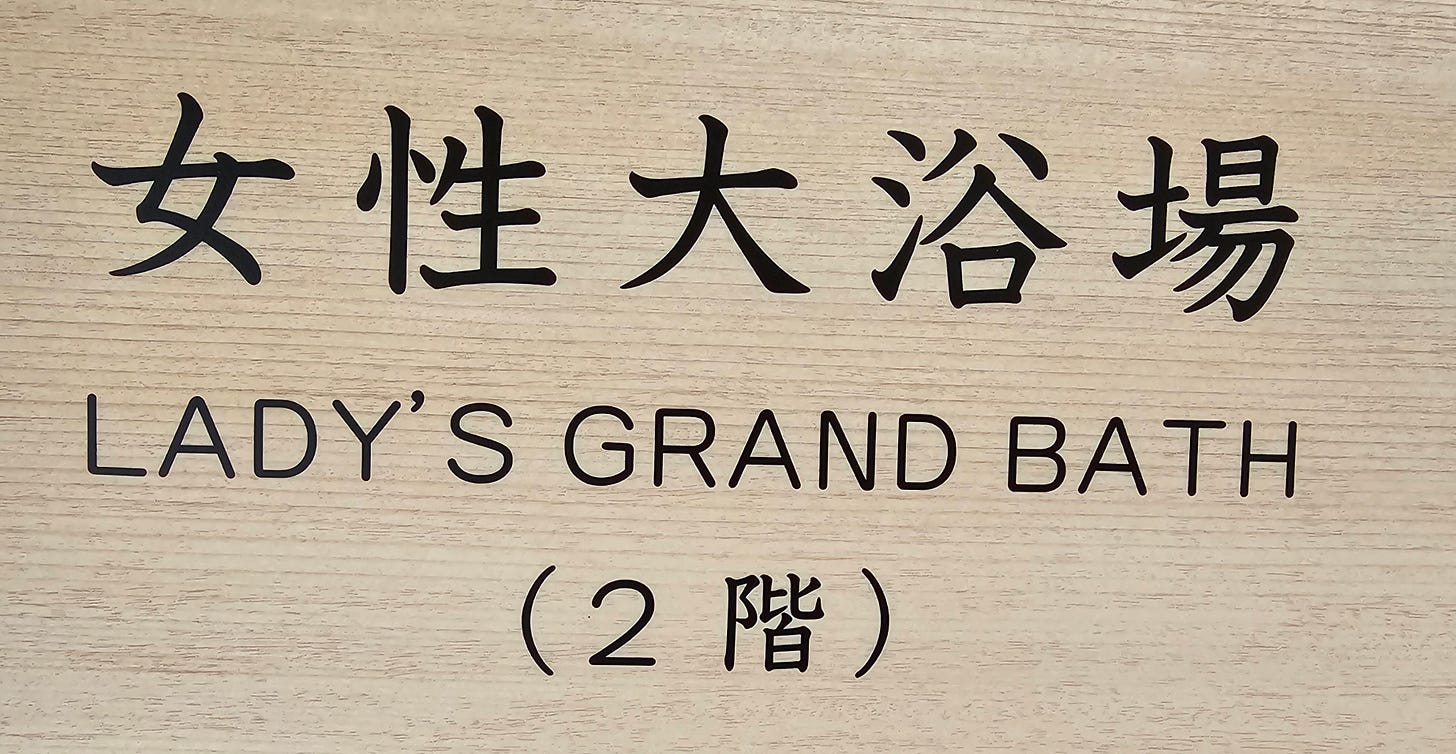
While there may be several baths to try, your first stop will likely be the "grand bath" or daiyokujyo (大浴場). The one for women is often called josei daiyokujyo (女性大浴場).
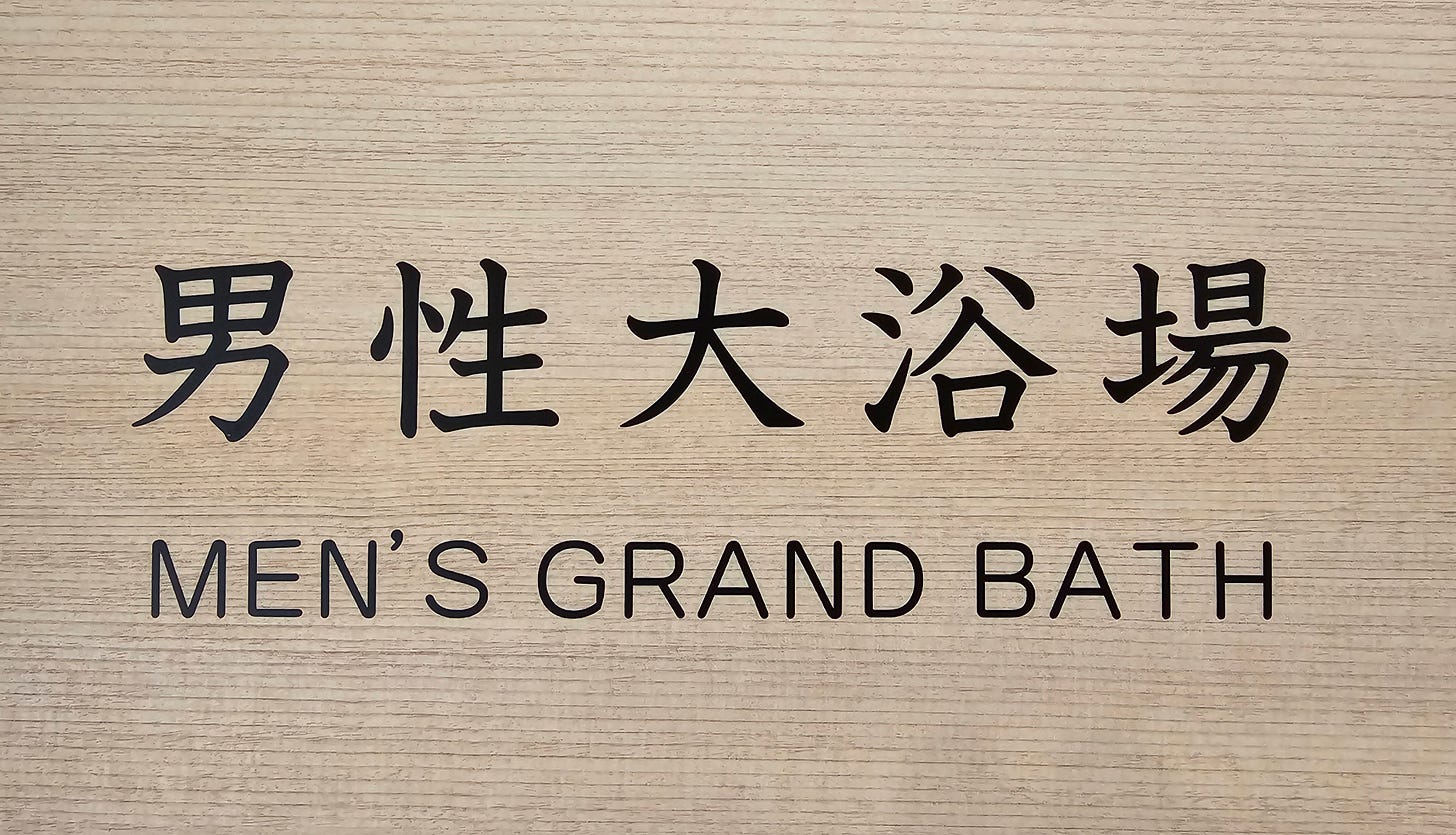
The bath for men is usually written as dansei daiyokujyo (男性大浴場). Most entrances are color-coded. In the examples shown below, the red entrance is marked onna yu (女湯) for the women's bath, and the blue entrance is otoko yu (男湯) for the men's bath.
Even in mixed bathing facilities, it is common to have separate entrances for men and women. In such locations, there is often a partition in the main bath beyond which it is possible for men and women to bathe together.
On the other side of this type of door, which may just be a cloth curtain called a noren (のれん), there is usually a place where you can take off your shoes or slippers and put them in a small cubby. This way, you will be barefoot (or wearing socks) when you enter the changing or “locker” room.
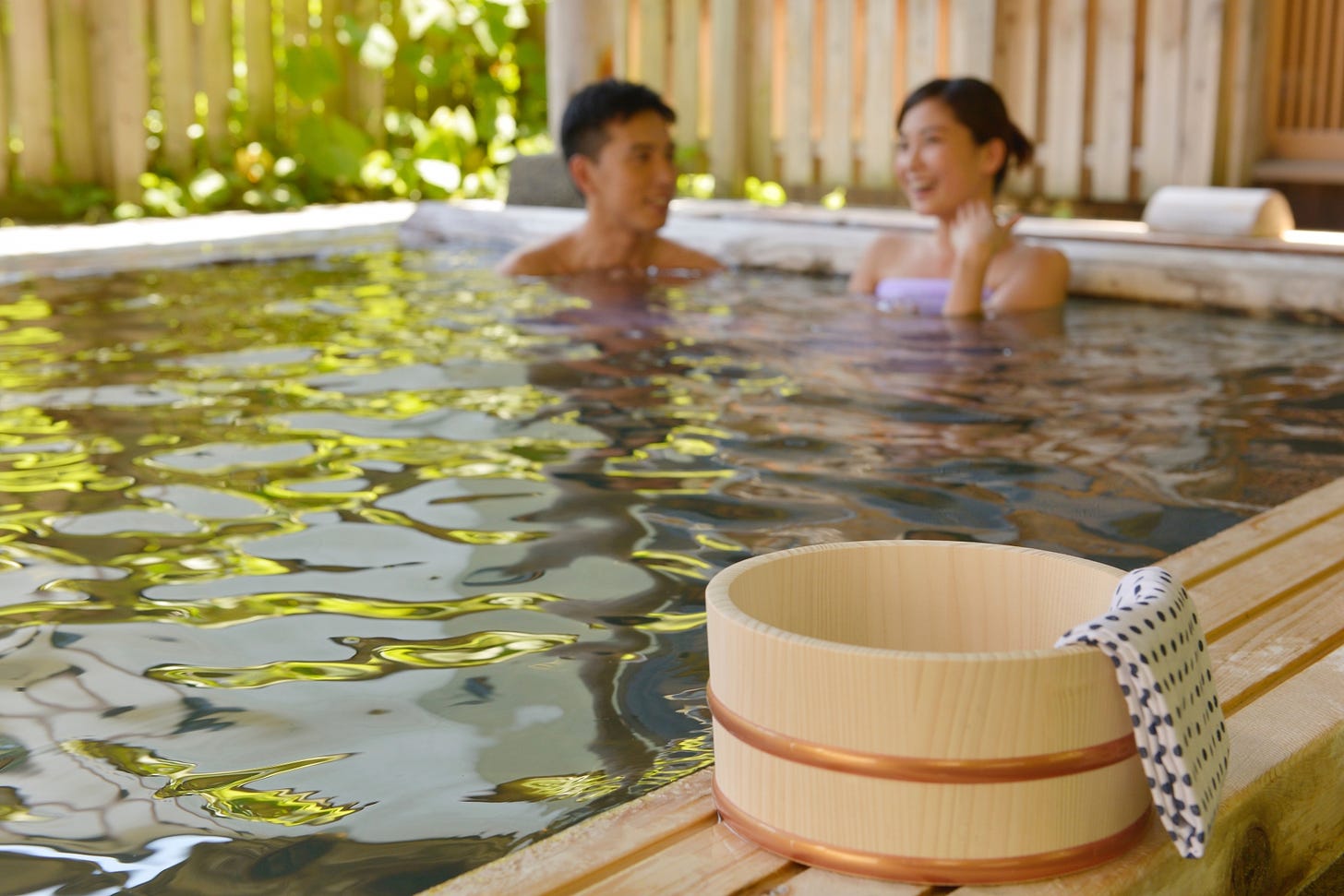
Private Baths or “Family” Baths
If you are too squeamish to enter a communal bath - whether gender-specific or for mixed bathing - another, more private option would be to bathe in a kazokuburo (家族風呂), which literally means "family bath" but can be used by couples or even by an individual.
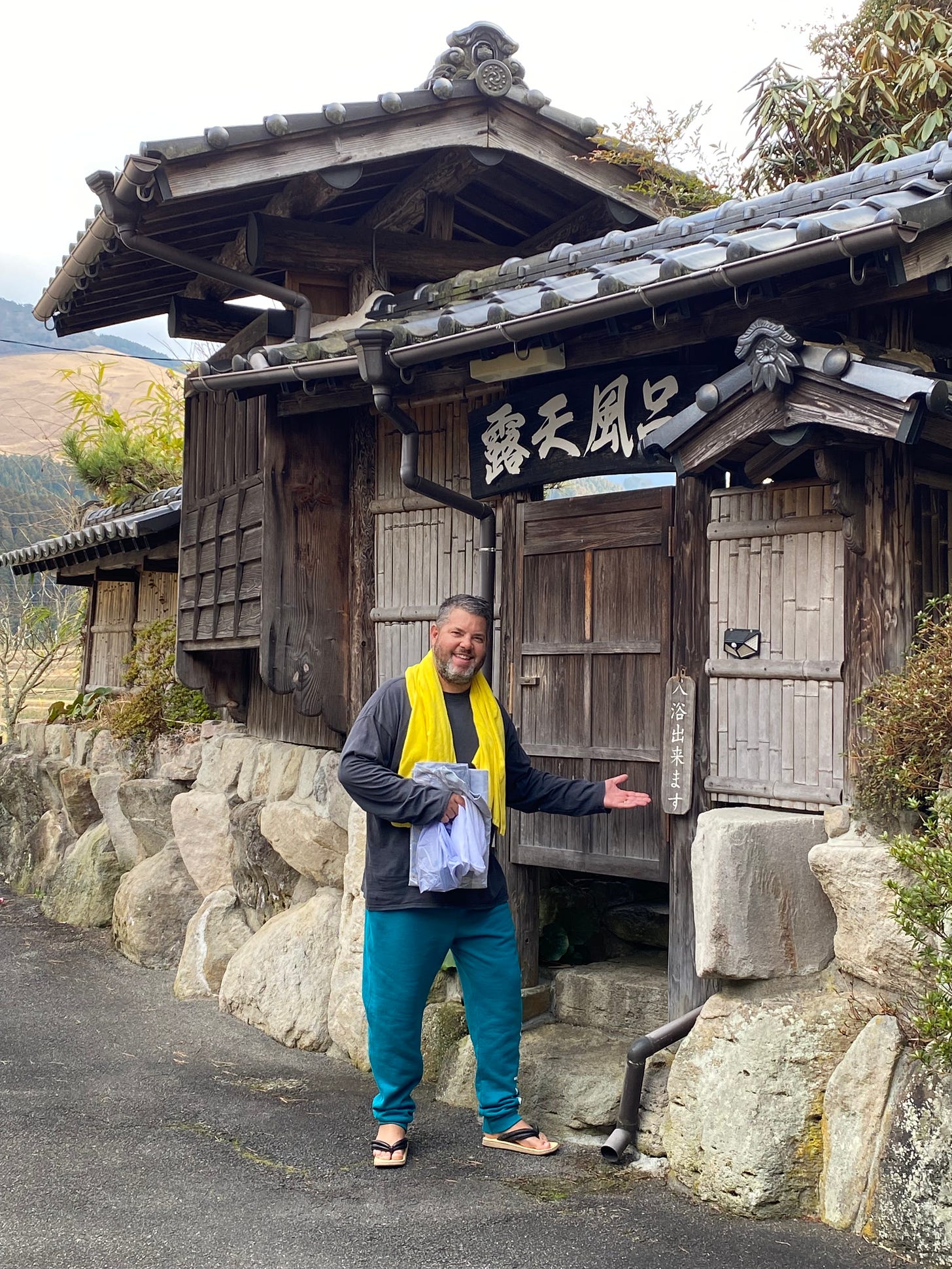
While some onsen have kazokuburo that must be reserved at the front desk and may require an extra fee, others are simply available on a first-come, first-served basis. When the door is locked, the bath is occupied.
Changing Area
Before entering the bath, you should remove all of your clothing and other personal items and leave them in the locker room. While there may be coin-operated lockers for valuables like your wallet, most facilities simply have small cubbies with a basket for your clothes.
Sometimes the unused baskets are turned upside down.
If this is the case, it is best to flip your basket (return it to its original position) when you are ready to leave after taking a bath.
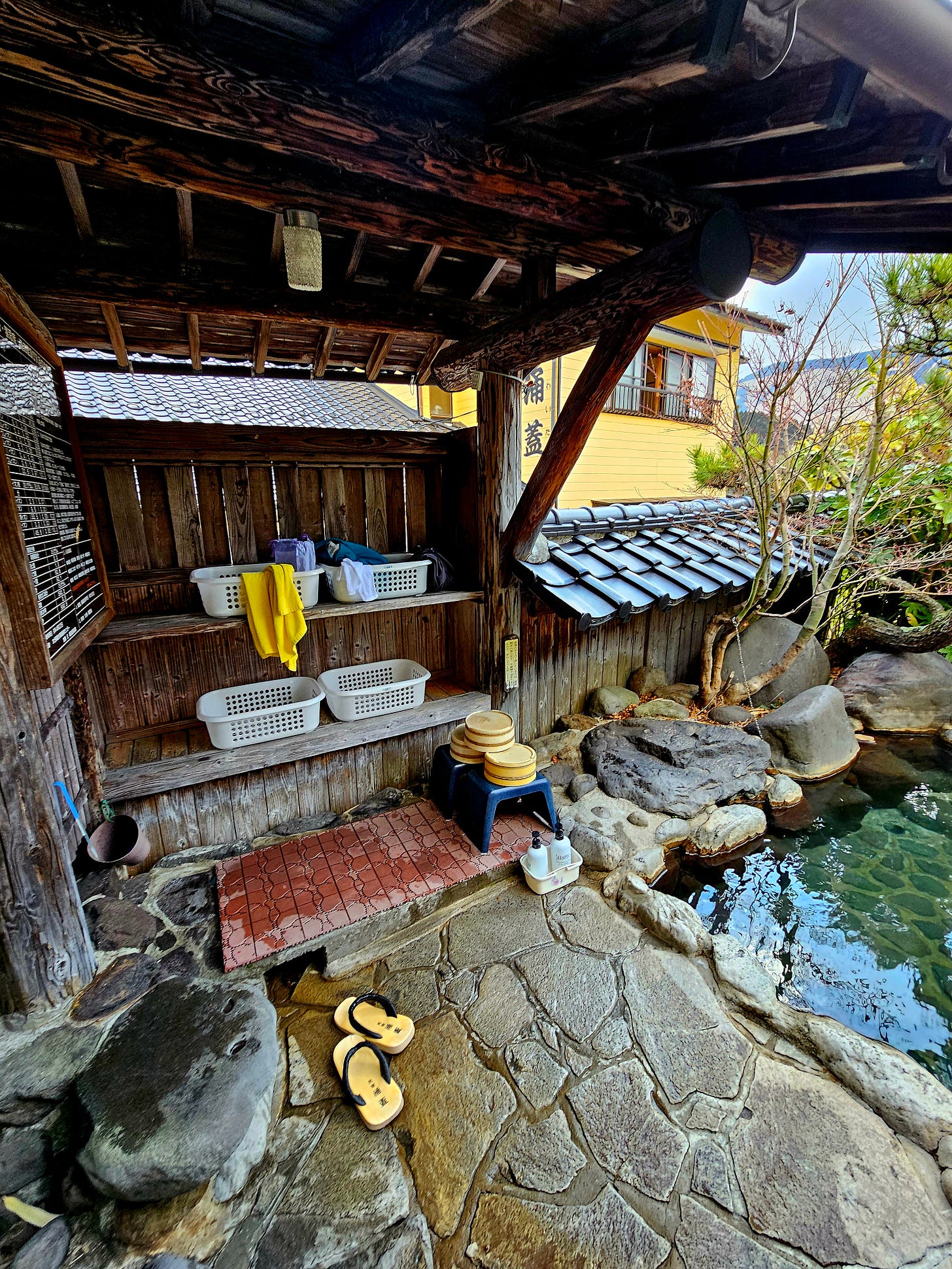
The changing area often has a small row of sinks with hair dryers.
Sometimes additional "amenities" such as hairbrushes, toothbrushes, etc. are available.
Rule Board
Even before you reach the bath, you are likely to be confronted with a giant rule board - many of which are now bilingual, with Japanese and English. Recently, signs in Korean and Chinese have also become more common.
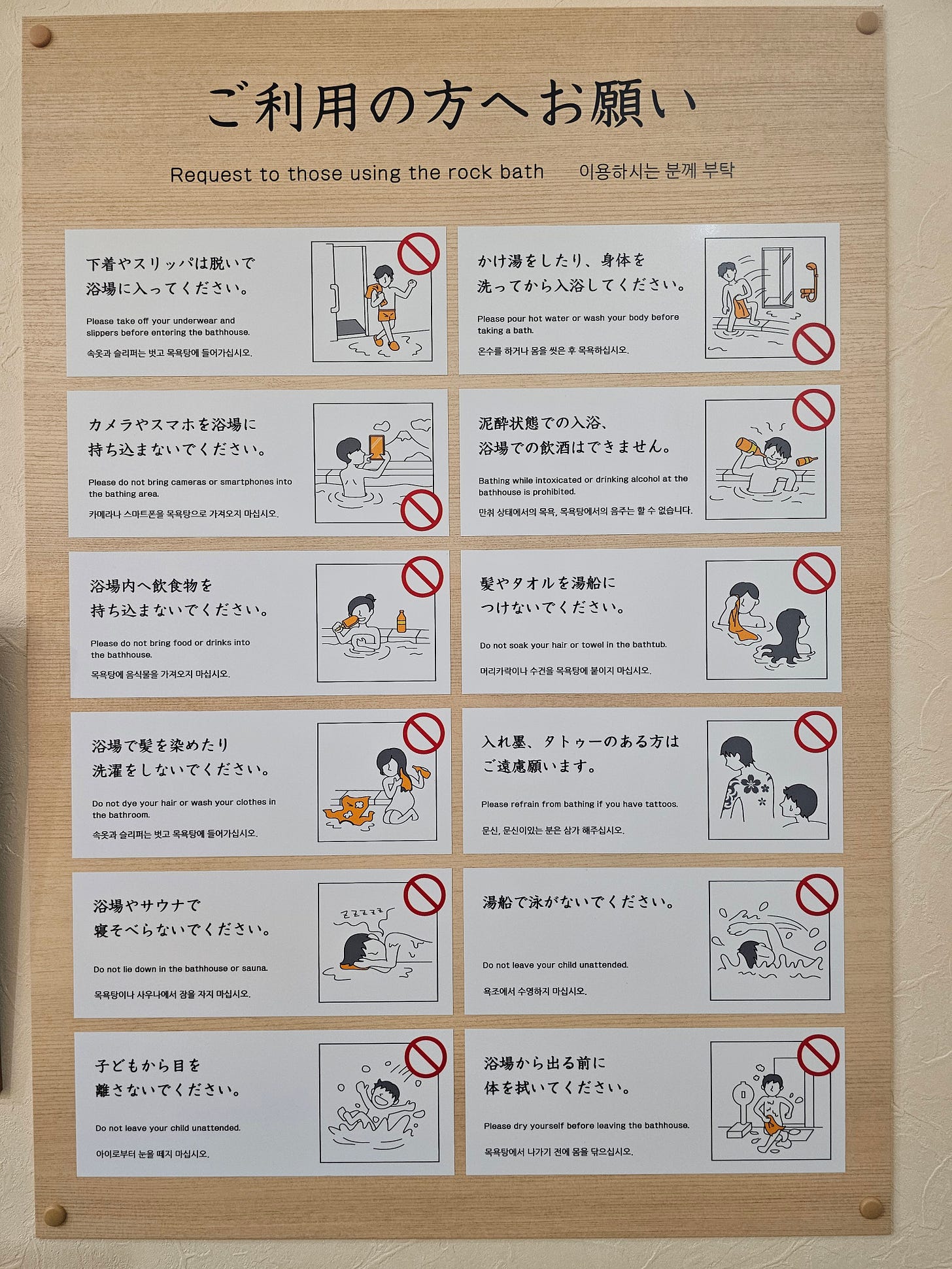
Zoom in: There is a lot going on here. So, let's unpack each of these 12 common rules (with a few corollaries) one by one.
Rule #1: No Clothes or Footwear in the Bath
The only thing you should bring into the bath is a small hand towel1. Most onsen provide this for "free" as part of the entrance fee. It is okay to take the small hand towel home as a souvenir, whereas if your hotel has also equipped you with a larger bath towel, it must be left at the inn. At most sento, however, it will be necessary to bring your own hand towel.
However, you may sometimes see locals bringing their own set of shampoo, conditioner, soap, etc. in a small water-resistant basket. While these people may temporarily leave their belongings in front of one of the sinks, they are expected to move them aside while taking a bath so that the next person can use the shower and faucet. However, this is often a source of considerable friction for many bathers who are confronted with a seemingly occupied seat when the owner of such private amenities is nowhere to be found.
The Japanese sign reads as follows:
Romaji: Shitagi ya surippa wa nuide yokujyo ni haitte kudasai.
Furigana: したぎやスリッパは脱いでよくじょうにはいってください。
With Kanji Characters: 下着やスリッパは脱いで浴場に入ってください。
Listen to Japanese:
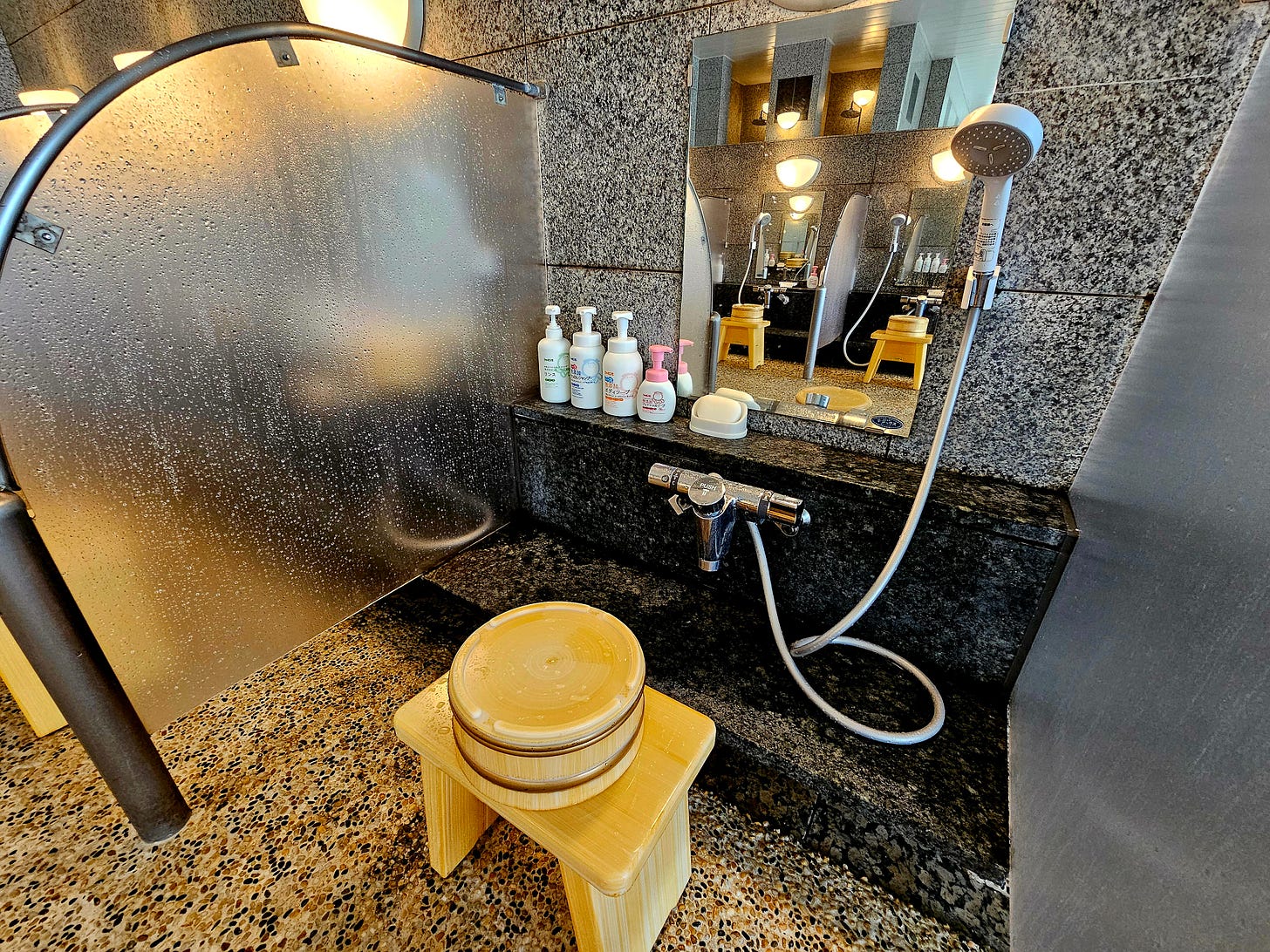
You may be wondering where you should leave your valuables if there is no coin locker. Good question. While it is probably best not to bring them in the first place, you should check to see if there are coin-operated lockers in the lobby of your inn. There may also be a safe in the room. In any case, the worst you can do is leave them in the unattended locker and hope they don't get stolen. Some people take these personal items into the bath area in a waterproof bag which they leave on the edge of the sink in plain sight, although you really shouldn't do this.
There are a few hot springs that have a swimsuit-friendly section, but they are still not very common. Besides, wearing a bathing suit kind of defeats the purpose of experiencing an authentic Japanese onsen or public bath.
While you will not find communal soap at every onsen or sento, most hot spring resorts provide "free" shampoo or shanpu (シャンプー), rinse or rinsu (リンス), body soap or bodi sopu (ボディソープ), or a bar of soap which is called sekken (石鹸) in Japanese. Some even have a separate facial soap or feisharu sopu (フェイシャルソープ).
Rule #2: No Photos
Guilty as charged! I have to admit that for the greater good of trying to explain some of the signage that appears at most onsen, I had to bend this particular rule a bit, although I did make sure to take photos only after I had the whole place to myself. In any case, don't take photos or videos anywhere in the bath. (Do as I say not as I do!)
The Japanese sign reads as follows:
Romaji: Kamera ya sumaho wo yokujo ni mochikomanaide kudasai.
Furigana: カメラやスマホをよくじょうにもちこまないでください。
With Kanji Characters: カメラやスマホを浴場に持ち込まないでください。
Listen to Japanese:
Rule #3: No Food or Drink
This particular rule may seem obvious, but it is posted for a reason. Don’t be “that guy” who takes ice cream (really?) into a hot bath.
The Japanese sign reads as follows:
Romaji: Yokujonai e inshokubutsu wo mochikomanaide kudasai.
Furigana: よくじょうないへいんしょくぶつをもちこまないでください。
With Kanji Characters: 浴場内へ飲食物を持ち込まないでください。
Listen to Japanese:
Rule #4: No Hair Dying or Laundry
You would be surprised how often this particular rule is broken. Again, it's best to just follow the rules. Many Japanese hotels have inexpensive coin-operated laundry facilities. So, use them.
The Japanese sign reads as follows:
Romaji: Yokujyo de kami wo sometari sentaku wo shinaide kudasai
Furigana: よくじょうでかみをそめたりせんたくをしないでください。
With Kanji Characters: 浴場で髪を染めたり洗濯をしないでください。
Listen to Japanese:
Rule #5: No Sleeping
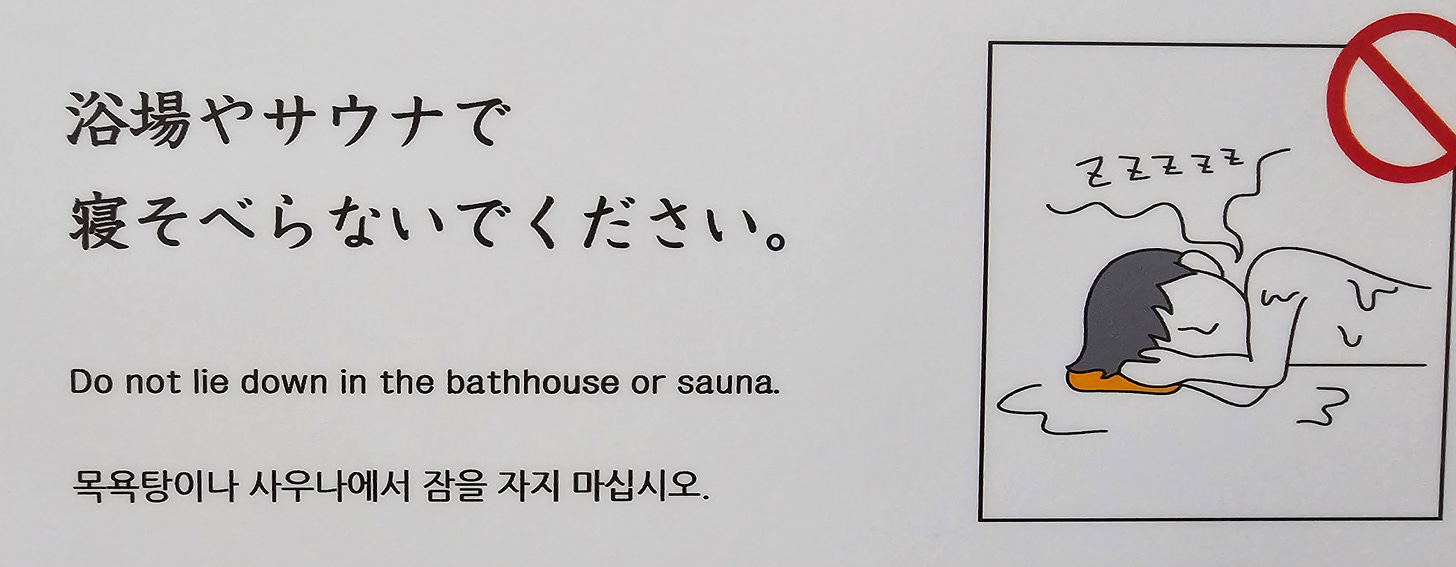
Once in a while you may see someone unconscious wearing nothing but their birthday suit. While the bath and sauna are meant for relaxation, there is a limit.
The Japanese sign reads as follows:
Romaji: Yokujo ya sauna de nesoberanaide kudasai
Furigana: よくじょうやサウナでねそべらないでください。
With Kanji Characters: 浴場やサウナで寝そべらないでください。
Listen to Japanese:
Rule #6: Watch Your Children
While the depth of a hot spring or public bath is generally not too deep, it is certainly deep enough to pose a risk of drowning, especially for a young child.
The Japanese sign reads as follows:
Romaji: Kodomo kara me wo hanasanaide kudasai
Furigana: こどもからめをはなさないでください。
With Kanji Characters: 子供から目を離さないでください。
Listen to Japanese:
At certain times of the day (e.g. early evening) it is common to see parents with small children in a public bath. Sometimes you may see mothers with their sons and fathers with their daughters. Until recently, some baths would even allow "children" up to the age of 13 to bathe with their parents of the opposite sex in a communal bath. It's hard to imagine a 13-year-old daughter being willing to enter the men's bathroom with her father, for example, but this particular scenario used to be okay. However, as of January 2022, only children up to the age of 5 are allowed to bathe with a parent of the opposite sex. So, you may see a sign stating this rule.
The Japanese sign reads as follows:
Romaji: Koshuyokujo wo goriyo no minasama he reiwa 4 nen 1 gatsu kara okosama wo isei no yokujo ni tsurete nyuyoku dekiru no ha 6 sai made ni narimasu!
Furigana: こうしゅうよくじょうをごりようのみなさまへ れいわ4ねん1がつから おこさまをいせいのよくじょうにつれてにゅうよくできるのは6さいまでになります!
With Kanji Characters: 公衆浴場をご利用の皆様へ 令和4年1月から お子さまを異性の浴場に連れて入浴できるのは6歳までになります!
Listen to Japanese:
It is also good to remember that communal bathing should be done in silence so as not to disturb others who are there to relax. Therefore, you may see a sign suggesting this behavior.
The Japanese sign reads as follows:
Romaji: Mokuyoku gokyoryoku kudasai
Furigana: もくよくにごきょうりょくください。
With Kanji Characters: 黙浴にご協力ください
Listen to Japanese:
This rule is definitely not always followed - especially in neighborhood sento - which have been used for millennia as a place to gossip with neighbors.
Rule #7: Wash before Entering the Bath
The tubs of an onsen and sento are for soaking. They are not intended as the place to get clean like a bubble bath. You should clean your body completely before you enter the bath. You wash in the area with small chairs in front of the sinks. Sometimes these areas have partitions that provide a degree of privacy, but this is not always the case.
Especially for foreigners, it is always a good idea to thoroughly wash your entire body from head to toe with soap, rinse off, and wash away any soap residue from your bathing area before entering the tub. While it may seem like no one is paying attention to you, some people may be checking to make sure you are following this rule, in particular. If they sense that you are doing something wrong, they may confront you directly or, more likely, simply complain to management.
The Japanese sign reads as follows:
Romaji: Kakeyu wo shitari, karada2 wo aratte kara nyuyoku shite kudasai
Furigana: かけゆをしたり、からだをあらってからにゅうよくしてください。
With Kanji Characters: かけ湯をしたり、身体を洗ってから入浴してください。
Listen to Japanese:
Despite this hard and fast rule, before washing with soap in front of a sink, especially in winter when the washing area may be a bit cold, you may observe an elderly Japanese person (usually) using the oke bucket to scoop up some hot water from the bath, dousing themselves - especially their midsection - and then taking a quick dip in the hot bath before washing thoroughly. Presumably they just want to warm up, but this practice seems to defeat the purpose of keeping the hot water everyone uses clean. If you see someone doing this, it is generally best not to imitate their actions and simply follow the rules by cleaning your entire body completely before entering the bath. Don’t give anyone a reason to complain.
Rule #8: No Drinking (Alcoholic Beverages)
As with the "no food or drink" rule listed above, to make sure their customers get the message, the spa with this sign felt the need to make it clear that by "no drinks" they mean alcoholic beverages, in particular. The owners are simply concerned about the safety of their guests. Drinking alcoholic beverages while taking a hot bath can lead to dehydration, impaired judgment, increased heart strain, heat stroke, etc.
However, at some onsen you may see people drinking sake or beer while taking a bath. So, it seems that this particular rule can be bent from time to time. However, if you must drink, it is best to do so after getting out of the bath, drying off, and returning to your room or going to a bar. You can wear your bathrobe or yukata (浴衣) to the karaoke lounge!
The Japanese sign reads as follows:
Romaji: Desui jyotai de nyuyoku, yokujo de no inshu wa dekimasen
Furigana: でいすいじょうたいでにゅうよく、よくじょうでのいんしゅはできません。
With Kanji Characters: 泥酔状態で入浴、浴場での飲酒はできません。
Listen to Japanese:
Rule #9: Keep Long Hair and Towels out of the Tub
You can place your towel on a rock or ledge by the side of the tub. It is also common to wrap a hand towel around your head or simply place it on top of your head while bathing.
The Japanese sign reads as follows:
Romaji: Kami ya taoru wo yubune ni tsukenaide kudasai
Furigana: かみやタオルをゆぶねにつけないでください。
With Kanji Characters: 髪やタオルを湯船につけないでください。
Listen to Japanese:
Rule #10: No Tattoos
Most onsen still do not allow people with tattoos to bathe in the communal baths. In Japan, tattoos have long been associated with the Yakuza, the country's organized crime syndicate. Thus, tattoos - especially full body tattoos - symbolize the mafia in Japan. Onsen are known for being relaxing and communal spaces, and some hot springs worry that people with tattoos might make other bathers uncomfortable and disrupt the peaceful atmosphere.
However, things are slowly changing. As more tourists visit Japan, many with tatts that have nothing to do with the Yakuza, the tattoo taboo is being re-evaluated. More and more onsen are becoming tattoo-friendly. The Japan National Tourism Organization is even working to encourage onsen to be more welcoming to tattooed guests.
The Japanese sign reads as follows:
Romaji: Irezumi, tato no aru kata ha goenryo negaimasu
Furigana: いれずみ、タトゥーのあるかたはごえんりょねがいます。
With Kanji Characters: 入れ墨、タトゥーのある方はご遠慮願います。
Listen to Japanese:
Rule #11: No Swimming
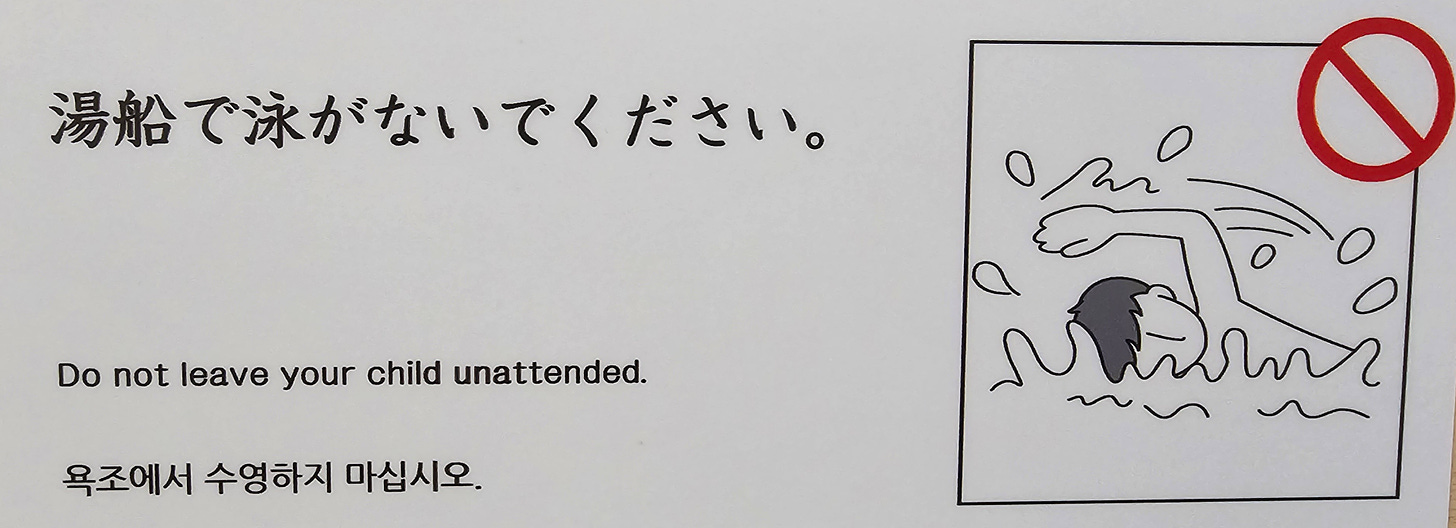
First, as you may have noticed, the English translation on the sign should read "No Swimming.” Onsen are places for relaxation and bathing, not for splashing around. Swimming can be disruptive to others trying to relax in the peaceful atmosphere. Plus, most onsen are not deep enough to do much more than a very shallow breast stroke.
The Japanese sign reads as follows:
Romaji: Yubune de oyoganaide kudasai
Furigana: ゆぶねでおよがないでください。
With Kanji Characters: 湯船で泳がないでください。
Listen to Japanese:
Rule #12: Dry off When Finished
Leaving a trail of dripping water can make the floor slippery and create a safety hazard for others. Wiping up excess water helps maintain a clean and safe environment for everyone.
The Japanese sign reads as follows:
Romaji: Yokujo kara deru mae ni karada wo fuite kudasai
Furigana: よくじょうからでるまえにからだをふいてください。
With Kanji Characters: 浴場から出る前に体を拭いてください。
Listen to Japanese:
You can dry yourself off with the same wet hand towel you bring into the bath area. What? Yes, I meant what I said. There is no need for a big bath towel. To bathe like a local, before returning to the changing area, simply wring out your small wet hand towel and then use it to sponge water off your hair and skin. It may take a few cycles of wringing out the towel and wiping your body to get somewhat dry. Most people do this while standing. While you may still feel a little clammy, you are now ready to return to the changing room, which often has a fan or senpuki (扇風機) and may even have air-conditioning or eacon (エアコン).
By drip-drying in front of an electric fan or simply sitting on a bench for a moment, you will become dry in no time.
Even if the fan only has Japanese listed on the control panel, it should be fairly intuitive as to how to operate it. Just in case, the on/off switch is usually marked with a button that says kiru (切), which means to turn off. In the case of this push-button panel, jaku (弱) means low, chu (中) means medium, and kyo (強) means high. There is a timer that can be set by rotating the arrow. I think you can handle it!
When you are finished with the towels to be returned to the inn, you should put them in the appropriate box. In this case, hand towels should be returned to the box labeled taoru kaishu BOX (タオル回収BOX), while large bath towels should be returned to the blue bag labeled basu taoru kaishu BOX (バスタオル回収BOX). As mentioned above, most people seem to take their hand towels home as souvenirs, which begs the question of why anyone would want to return their hand towel. Just go with the flow.
Finally, while there may be a designated smoking area outside the building (not in an outdoor rotenburo), it is generally best not to smoke anywhere inside the bathing area.
Extra Rule: No Smoking
The Japanese sign reads as follows:
Romaji: Daiyokujo kinen gokyoryoku negaimasui
Furigana: だいよくじょうきんえん ごきょうりょくねがいます
With Kanji Characters: 大浴場禁煙 ご協力願います
Listen to Japanese:
Commentary: As a resident of Oita Prefecture, the state with the most onsen in Japan, I probably visit a hot spring at least 3 or 4 times a month (more often during the winter months). Oita Prefecture holds the record for both the number of sources and the highest volume of hot spring water output. With over 5,000 onsen in the prefecture, I have only scratched the surface after living here for 5 years. So, while I haven't yet reached the level of "onsen meister3" (yes, that's a real thing), I can safely say that I have reached the stage of "onsen maniac" in Japanese!
Japan is a nation of rule makers and rule followers. As a short- or long-term guest, it is better to get used to this fact of life than to fret about how certain rules seem superfluous.
However, there is no need to lose sleep over whether you will be able to follow all the rules. The whole point of going to a spa is not only to get clean, but also to relax. Most of these guidelines are based on simple common sense. Therefore, following the rules will probably come naturally to most people. However, it is wise to familiarize yourself with the rules before your first visit to an onsen or public bath. After your first deep soak, bathing etiquette will come naturally.
Following the rules will make it easier simply to enjoy the experience.
What’s next: While seeing the sights, eating the food, riding the bullet train, etc. are all good things to do during any visit to Japan, the quintessential Japanese experience is visiting an onsen.
According to a survey by the Japan Tourism Agency, over 80% of foreign tourists who visit Japan are interested in visiting an onsen. However, a study by Mai-ko4 found that only about 20% of foreign tourists actually visit one during their trip to Japan. This is likely due to a number of factors, including discomfort with nudity, difficulty finding mixed-gender onsen, and concerns about etiquette. Therefore, there is a lot of untapped potential for hot springs and public baths to welcome more foreign guests in the future.
What do you think? What’s your attitude regarding onsen? All answers are completely anonymous, even to the author.
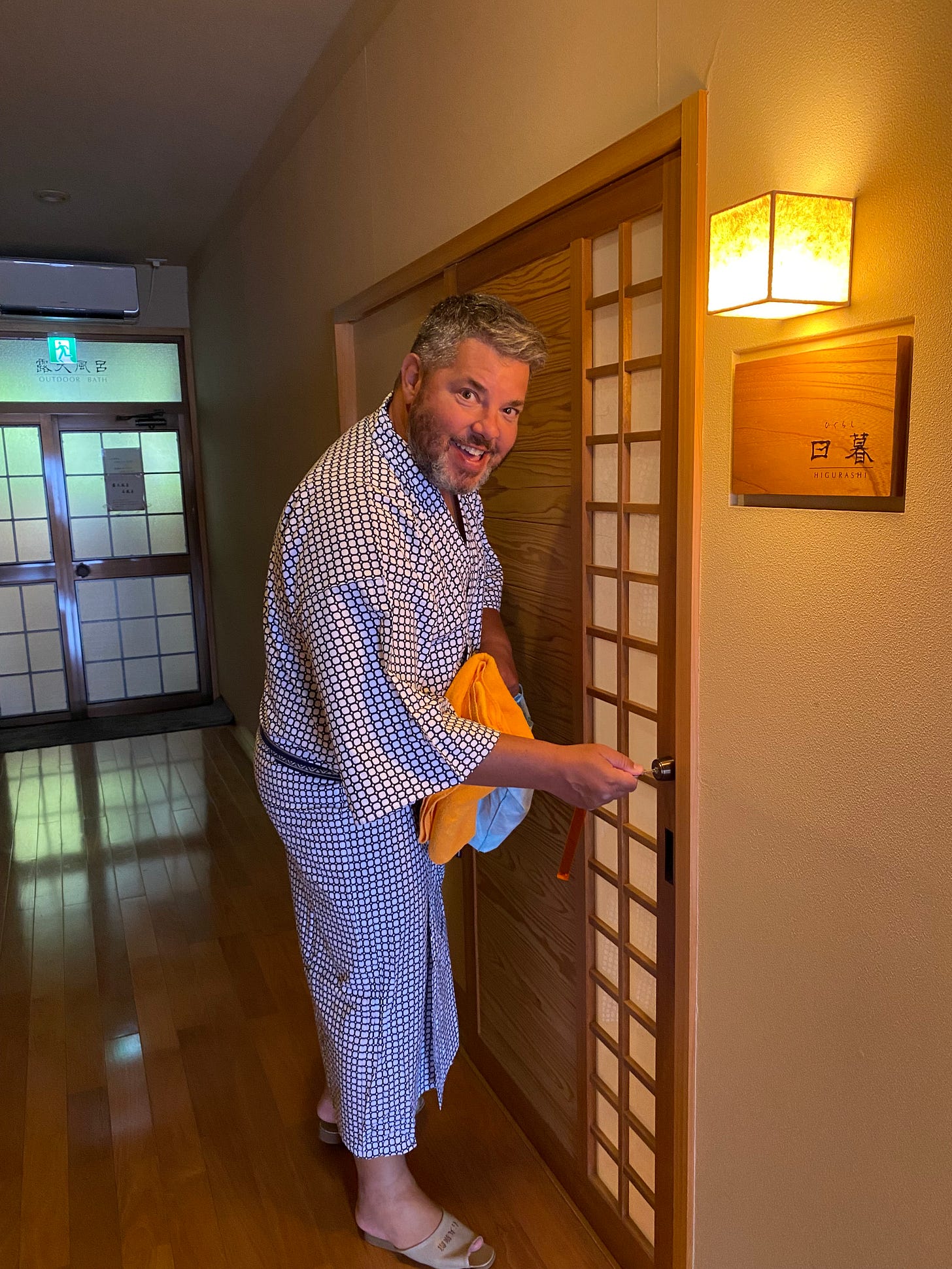
#OnsenMeister #onsen #HotSpring #bath #spa #sauna #CommunalBath #MixedBathing #Japanese #JapaneseLanguage #温泉マイスター #温泉 #お湯 #浴場 #銭湯 #大浴場 #家族風呂 #湯船 #混浴 #サウナ #湯着 #湯着付 #日本語
Please note that you can subscribe to Real Gaijin for free. If you are so inclined, you can also purchase an annual subscription for a relatively small fee.
However, I understand that even the lowest level of annual subscription allowed by Substack may seem too high for many. If you just want to buy a coffee for Real Gaijin (or maybe a green tea), you can also make a small donation here:
https://buymeacoffee.com/realgaijin
All levels of support - including just liking a particular article and/or leaving a comment - are very welcome. Thanks again for reading.
While Real Gaijin lives in Substack, you can also find Real Gaijin on a few other platforms (listed in alphabetical order).
https://www.instagram.com/real_gaijin_on_substack/
https://www.threads.net/@real_gaijin_on_substack
https://www.tiktok.com/@real.gaijin
https://www.youtube.com/@RealGaijin
https://www.linkedin.com/in/mark-kennedy-5b50b71/
However, in mixed bathing facilities, women may wear a loose-fitting garment called a yuami (湯着). It is also sometimes called a yuamizuke (湯着付). Usually, yuami can be purchased at the small shop near the entrance of an onsen that has konyoku. By the way, the guys literally just let it all hang out and go naked at such mixed bathing hot springs.
The Kanji characters 身体 can also be read as shintai (しんたい) instead of karada (からだ).
Although not a recognized certification or official title, the term onsen meister (温泉マイスター), which is derived from the Japanese word for hot spring or onsen (温泉) and the German loanword meister (マイスター) meaning "master" or "expert," is used playfully among onsen practitioners. The title can be used to describe onsen enthusiasts who have extensive knowledge and experience in visiting hot springs. Many hot springs advertise that they have one or more "onsen meisters" on staff.
ONSEN Study: Stats and Facts from the Perspective of Foreign Tourists
Subscribe to Real Gaijin
Unveiling the Real Japan: An American Expat's Inside Look | Hot takes, commentary, and unfiltered insights on life as a foreigner in Japan.






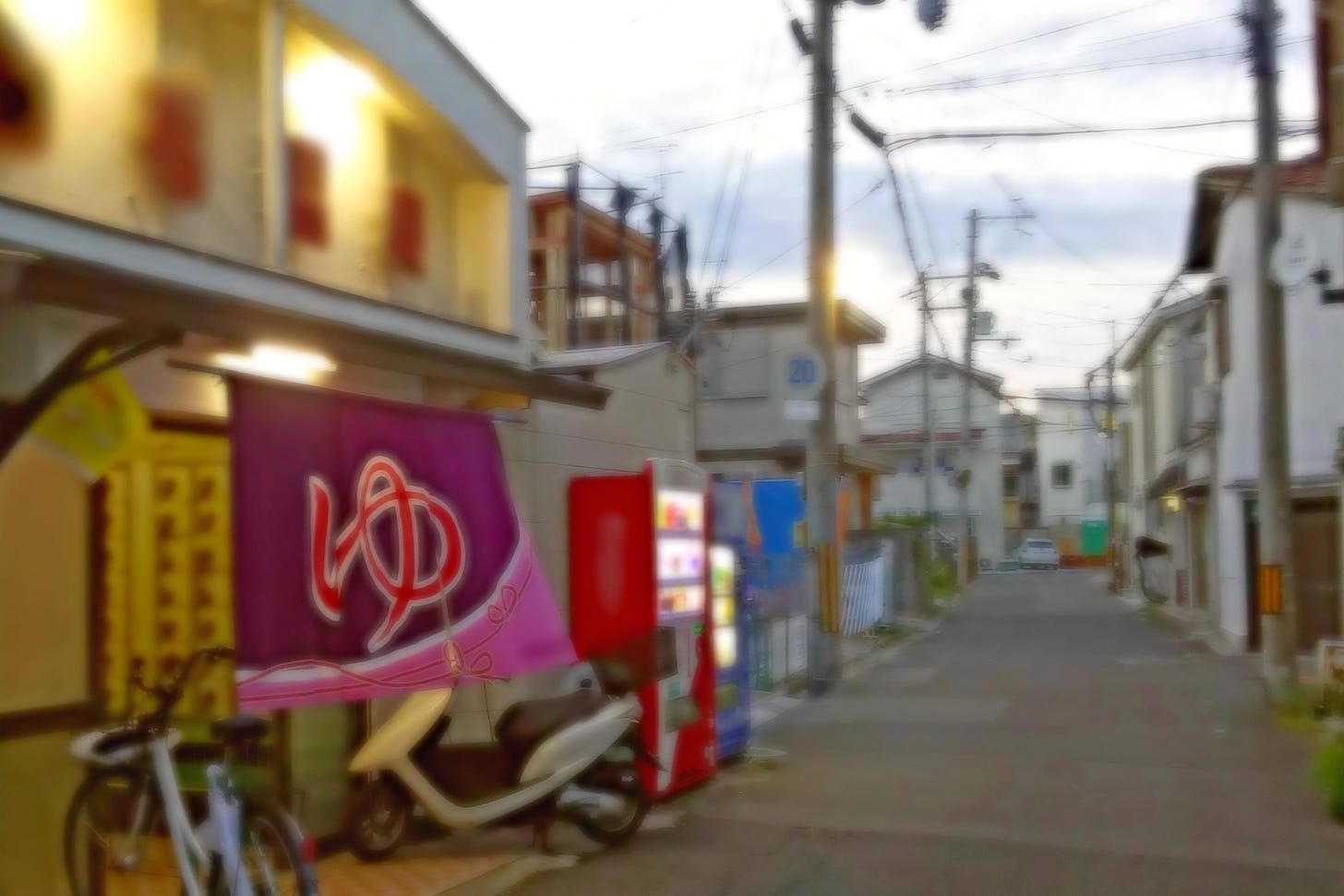

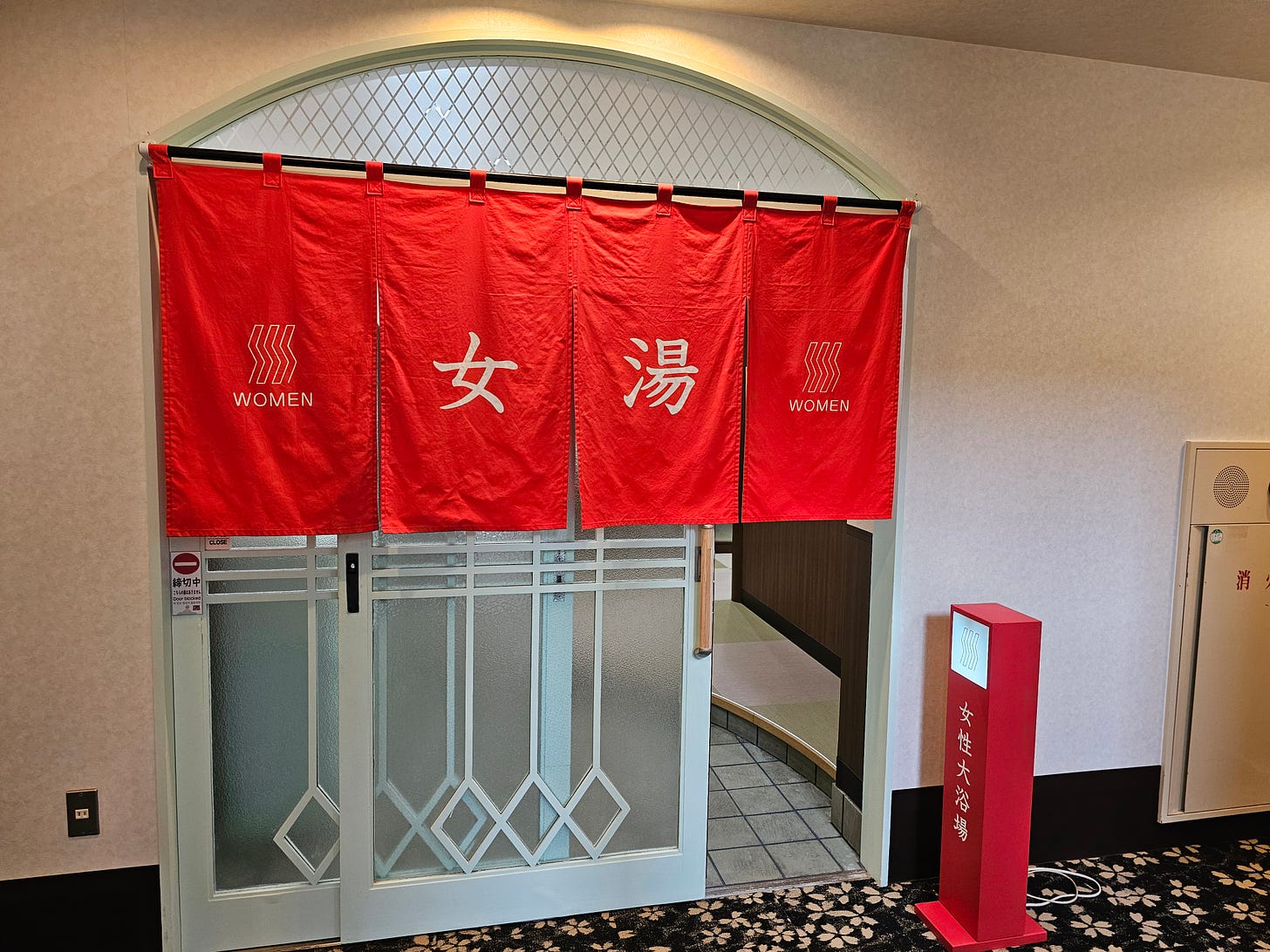
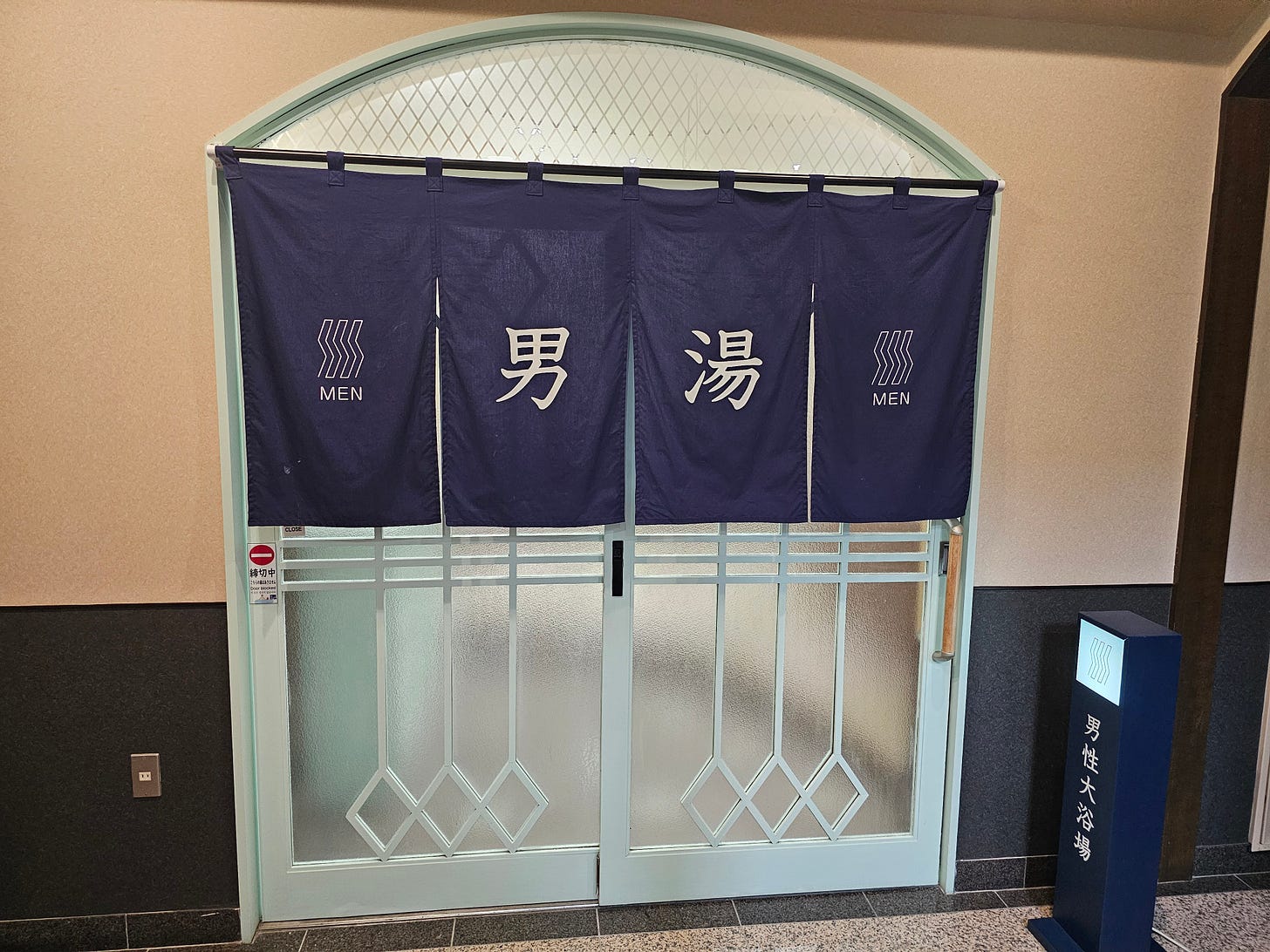
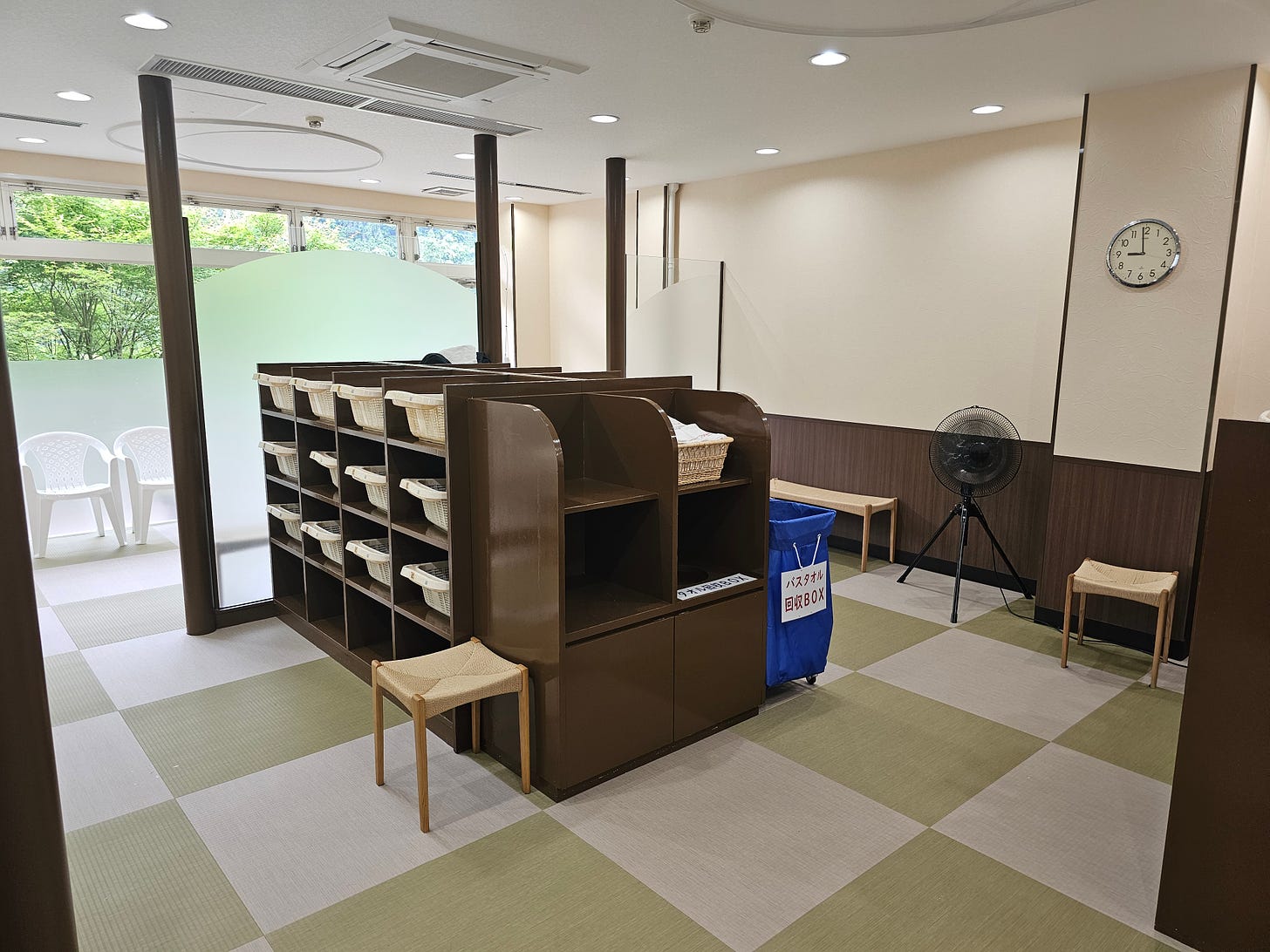
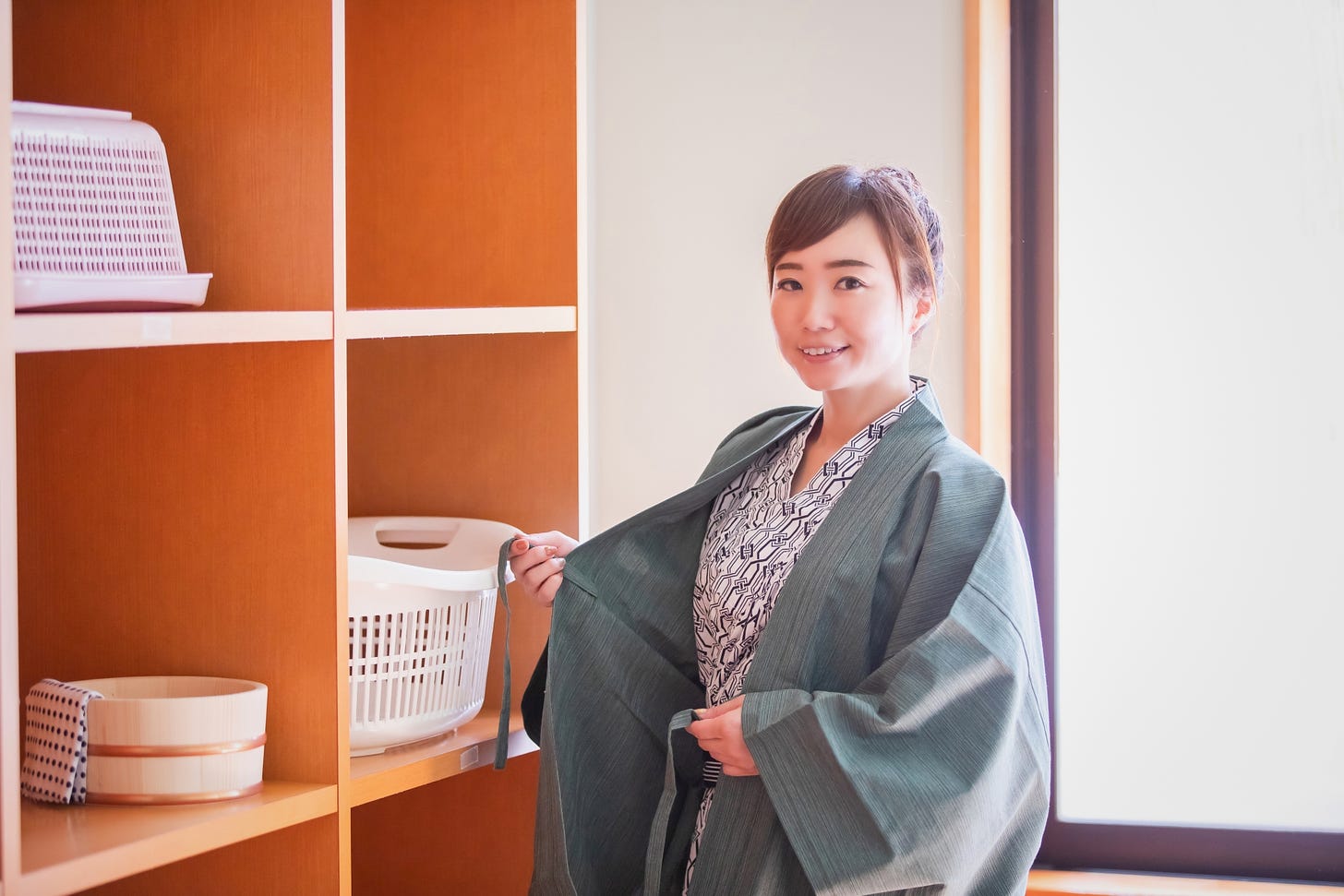
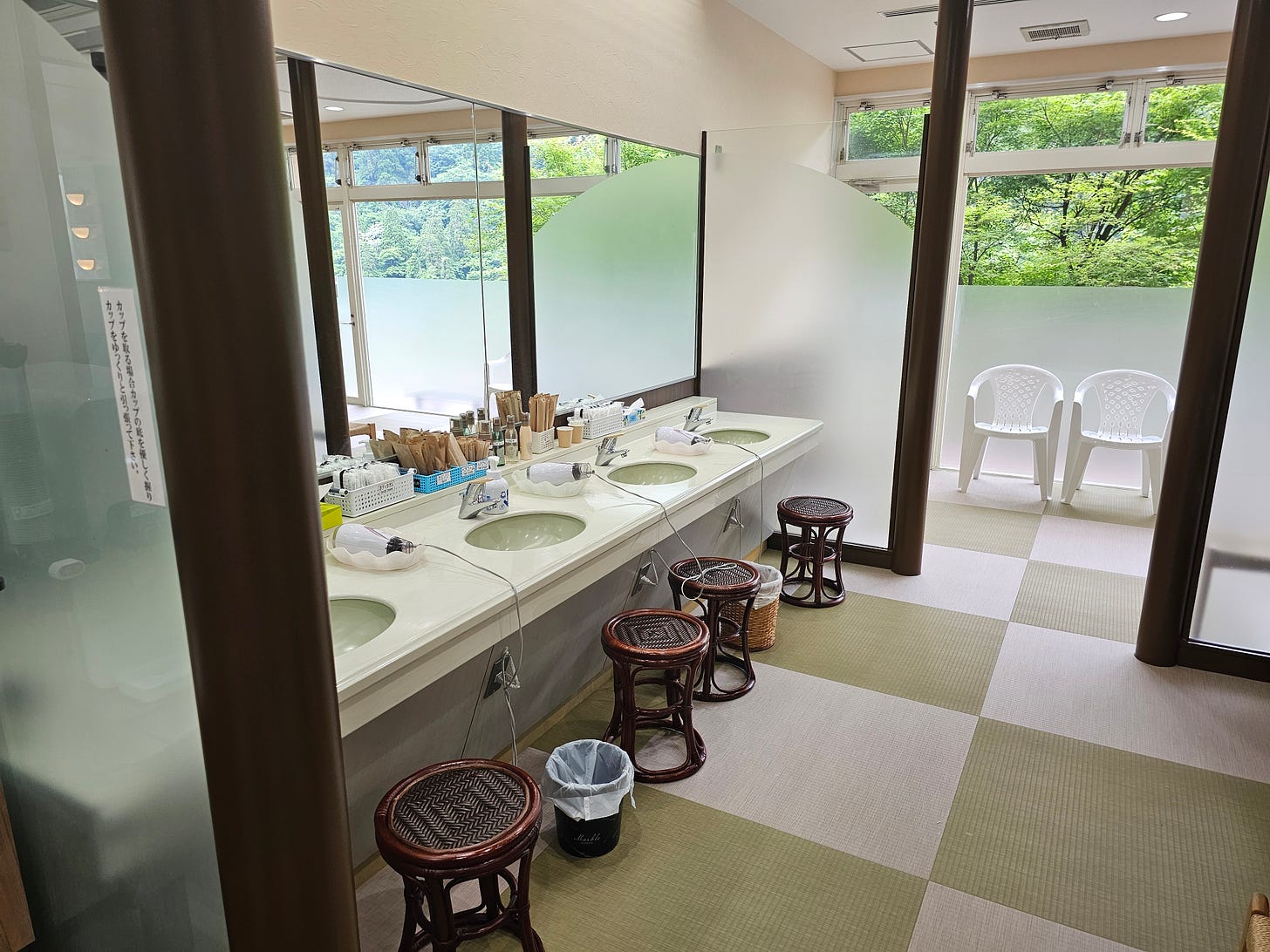
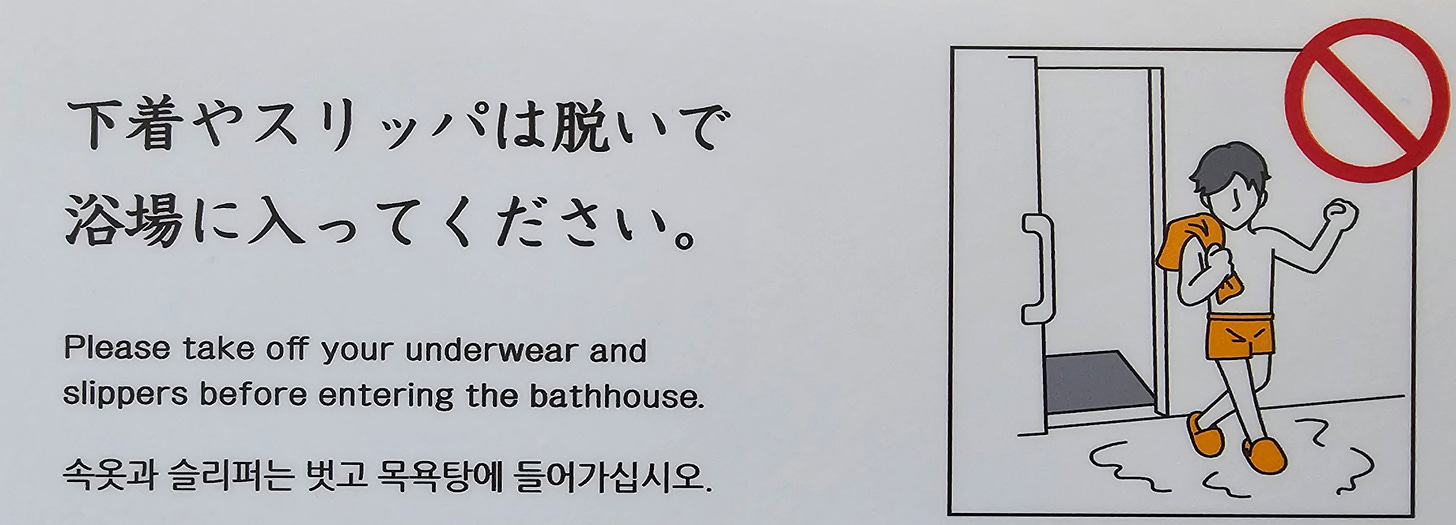
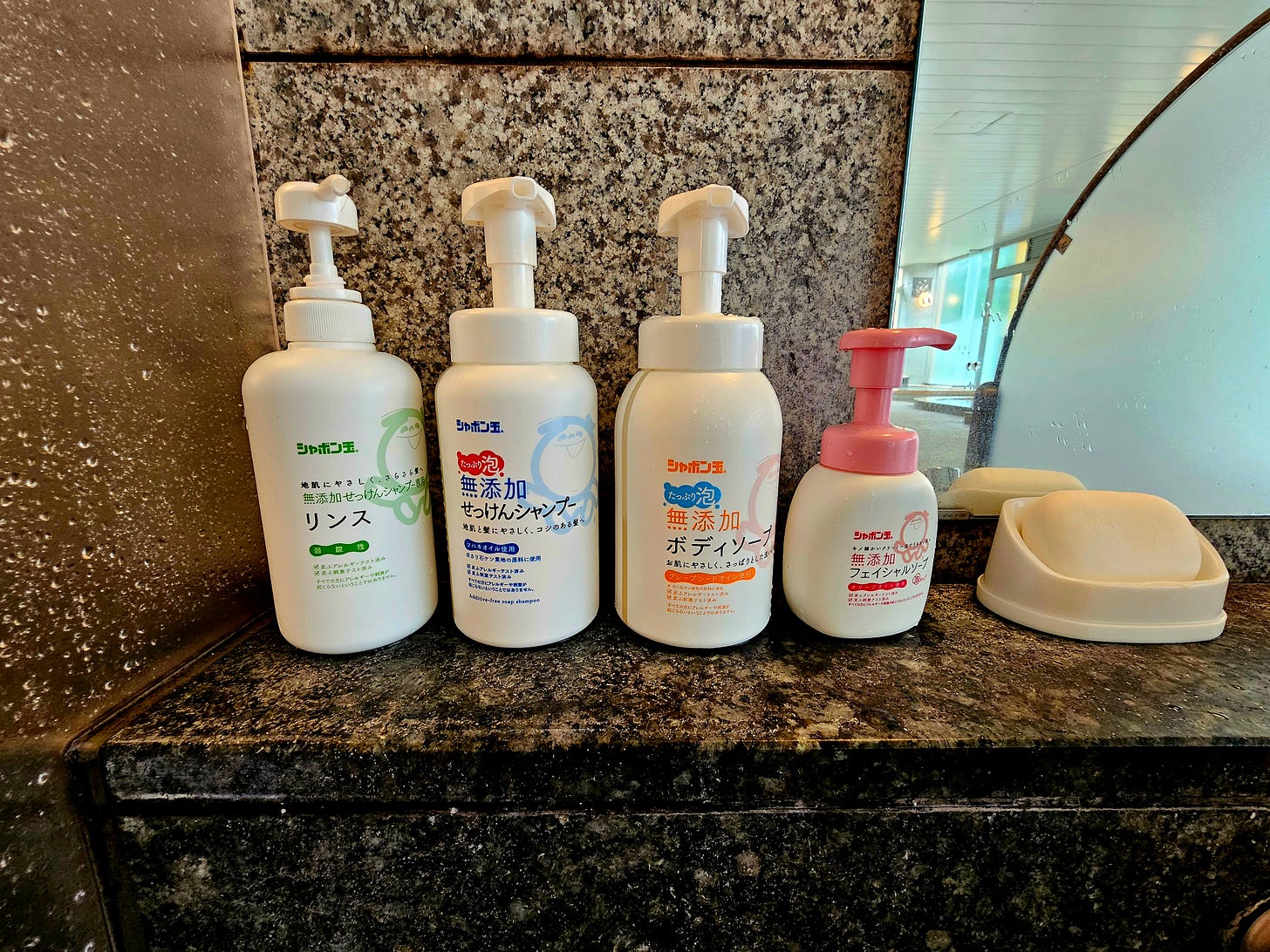
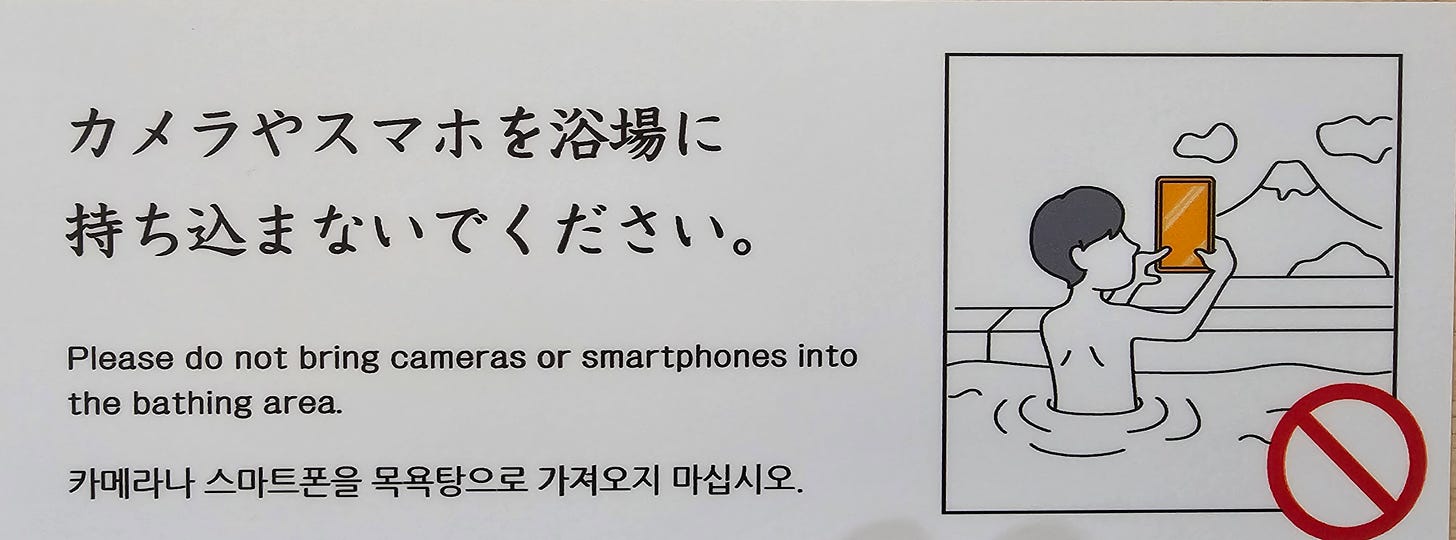
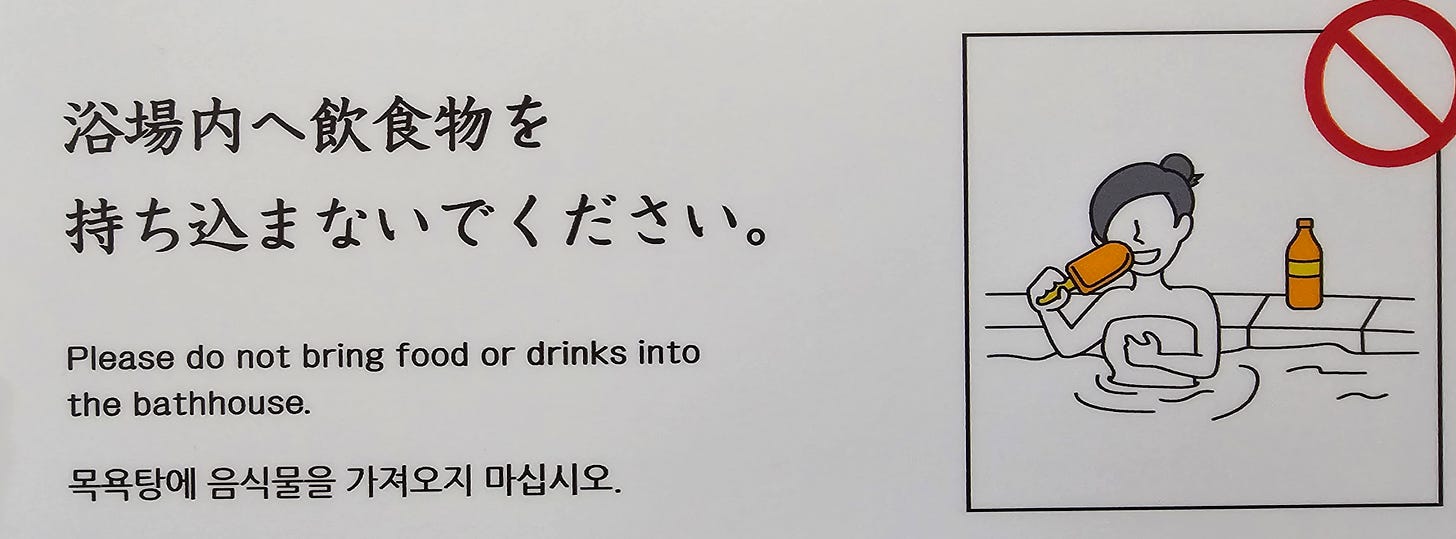
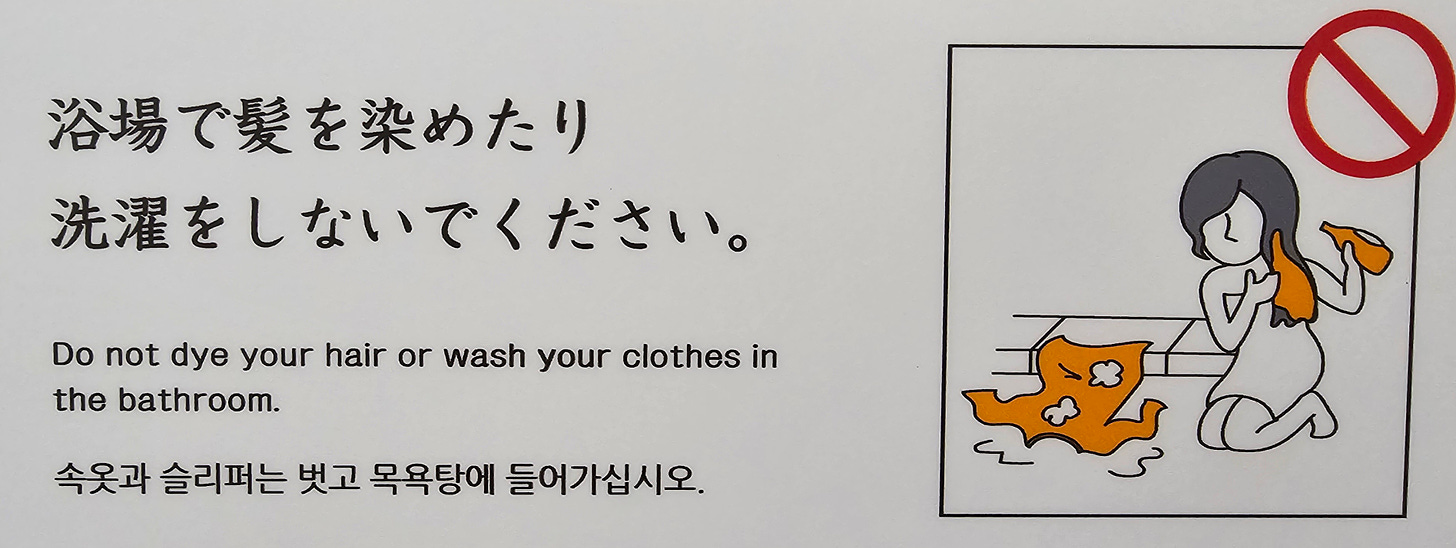
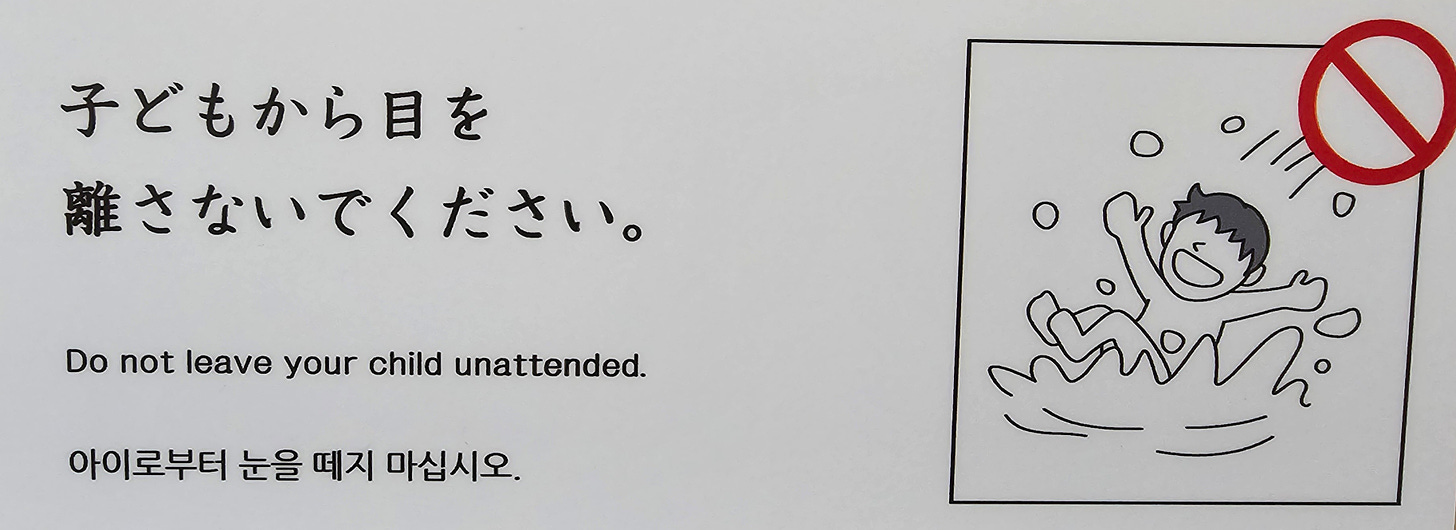
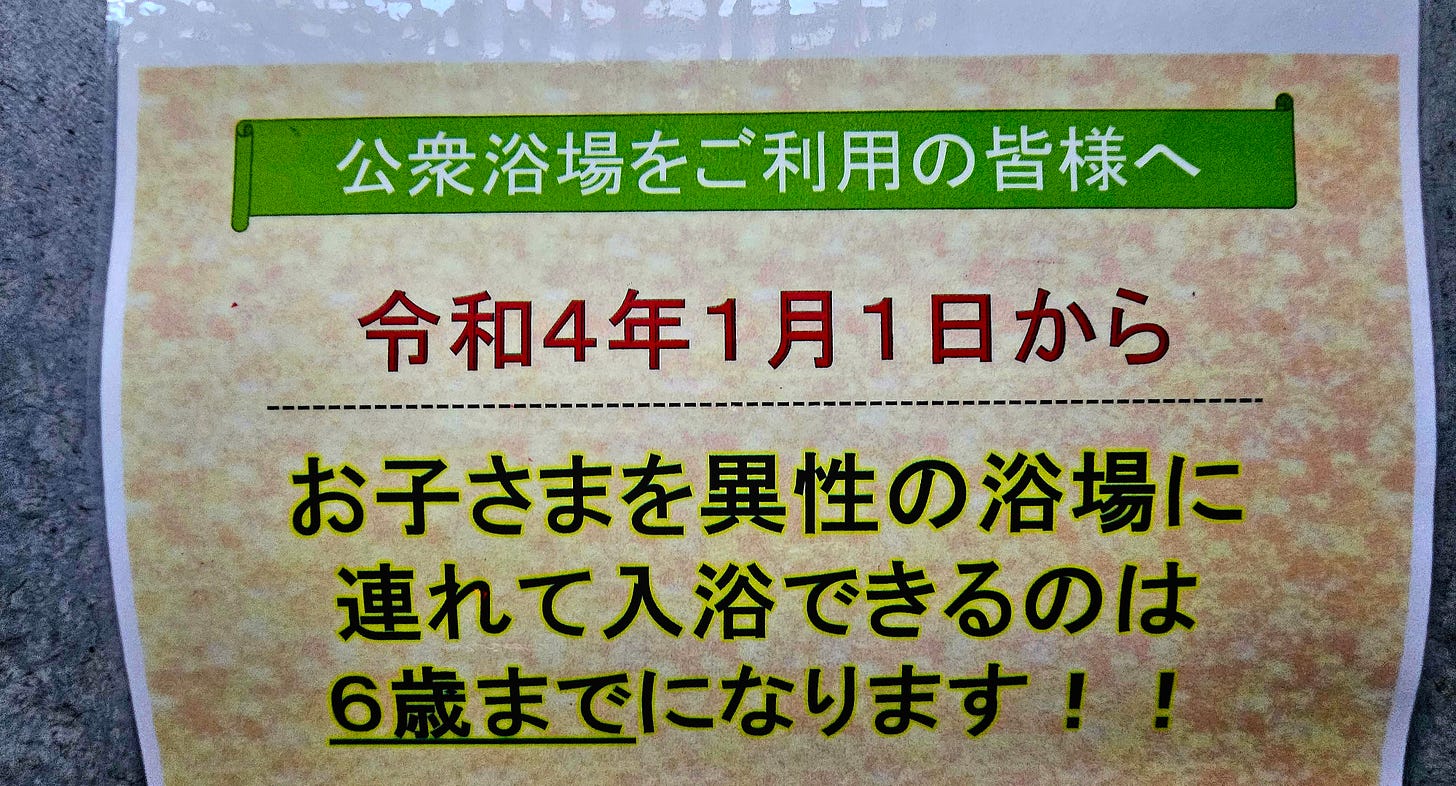
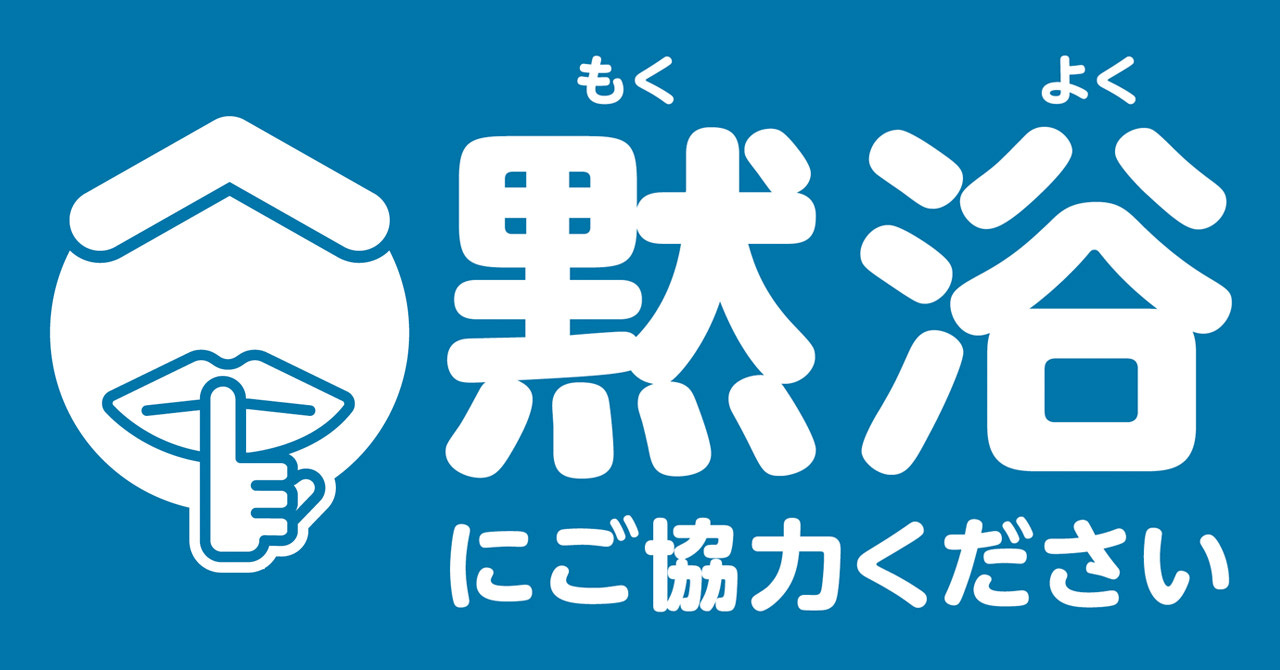
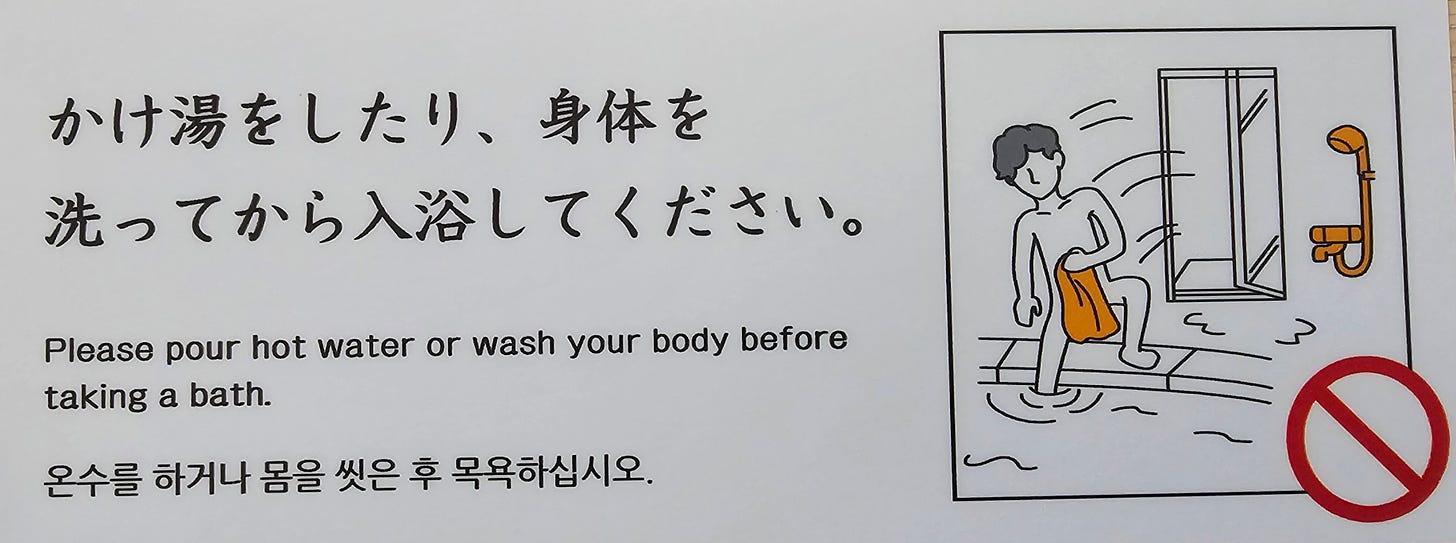
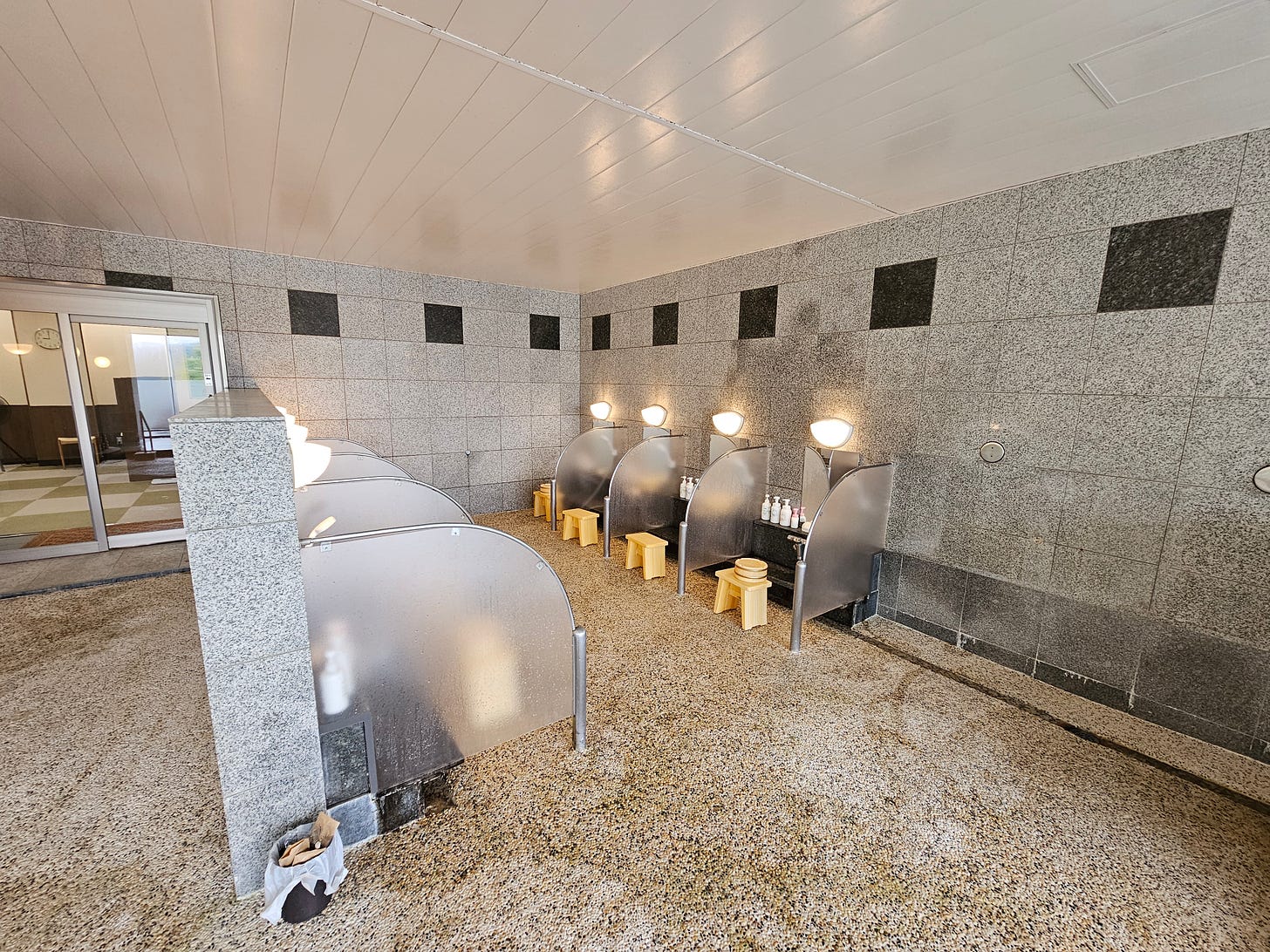
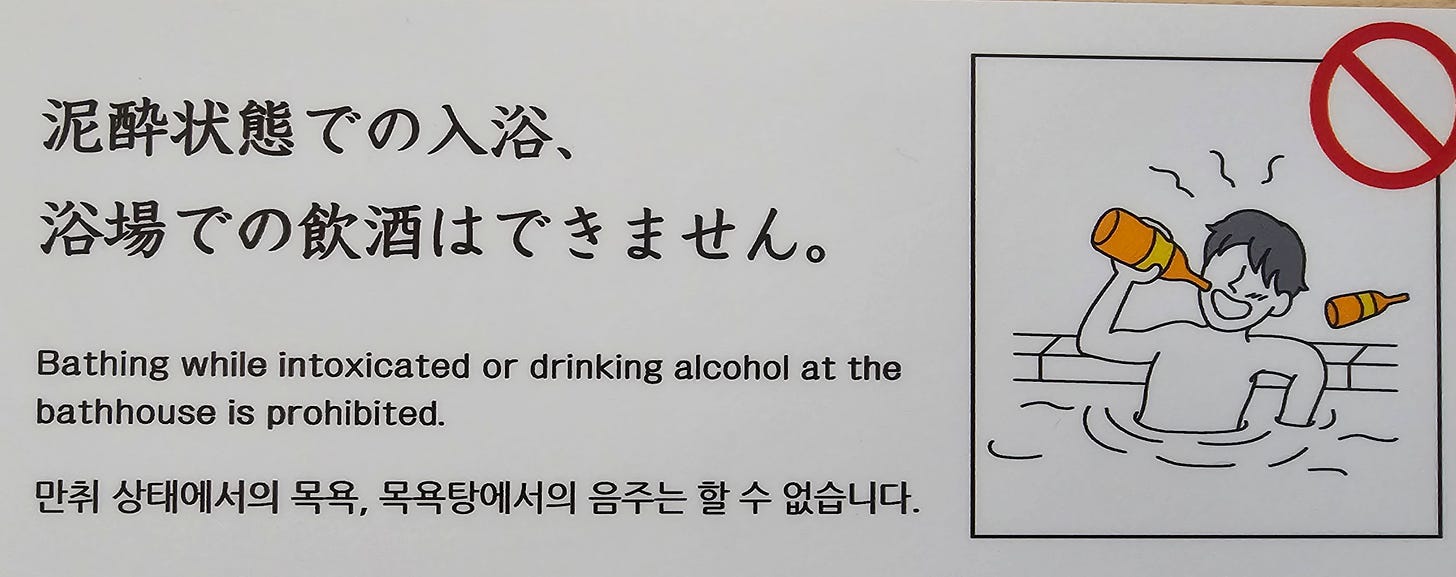
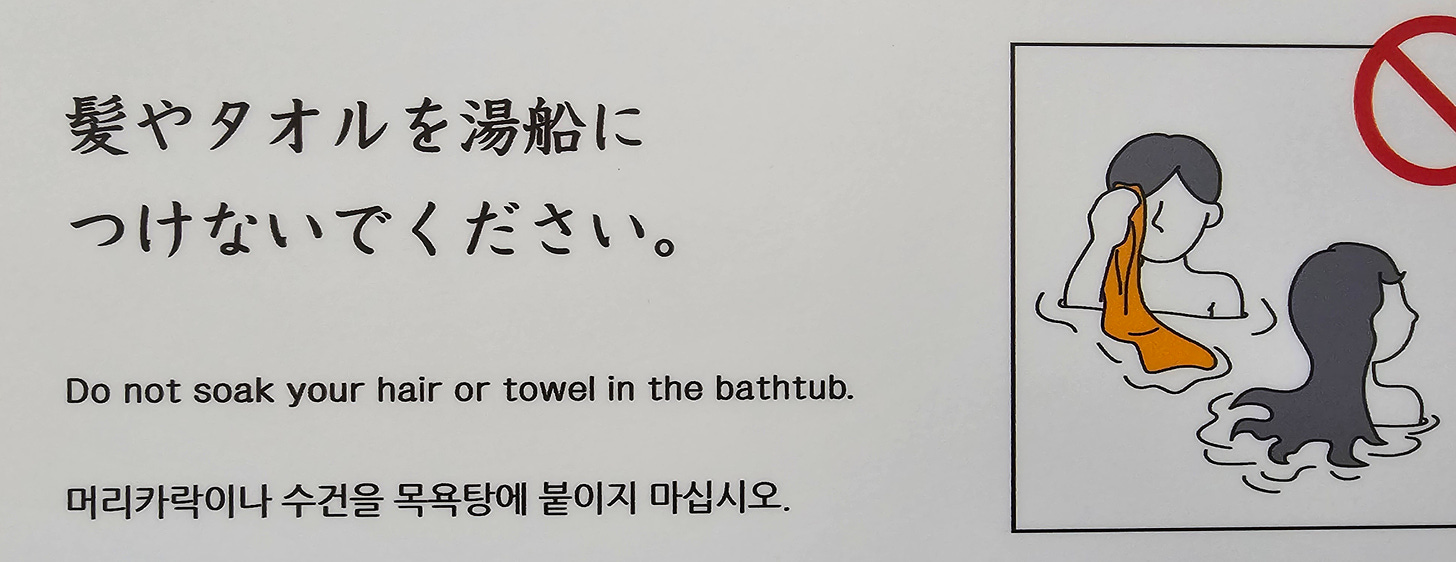
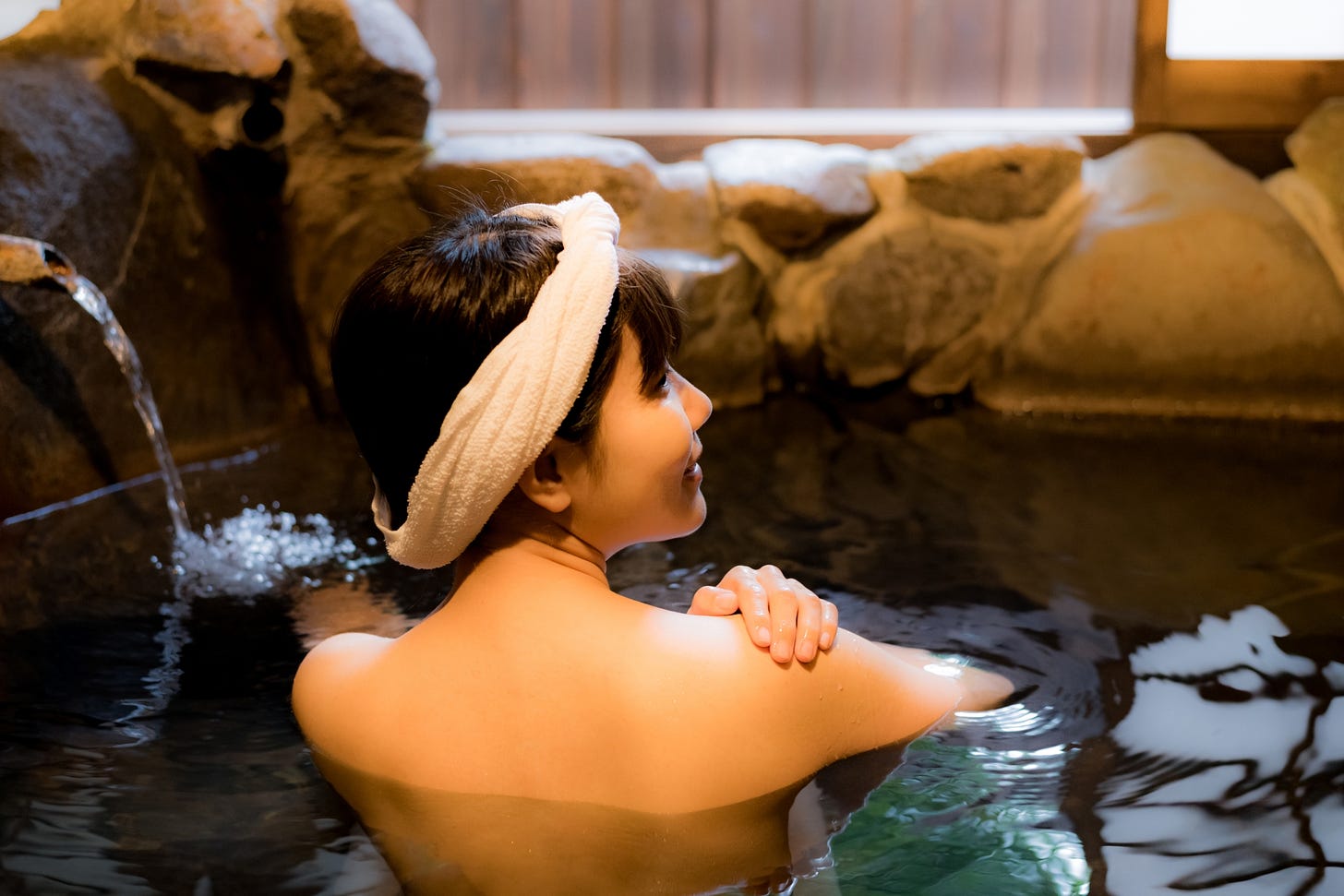
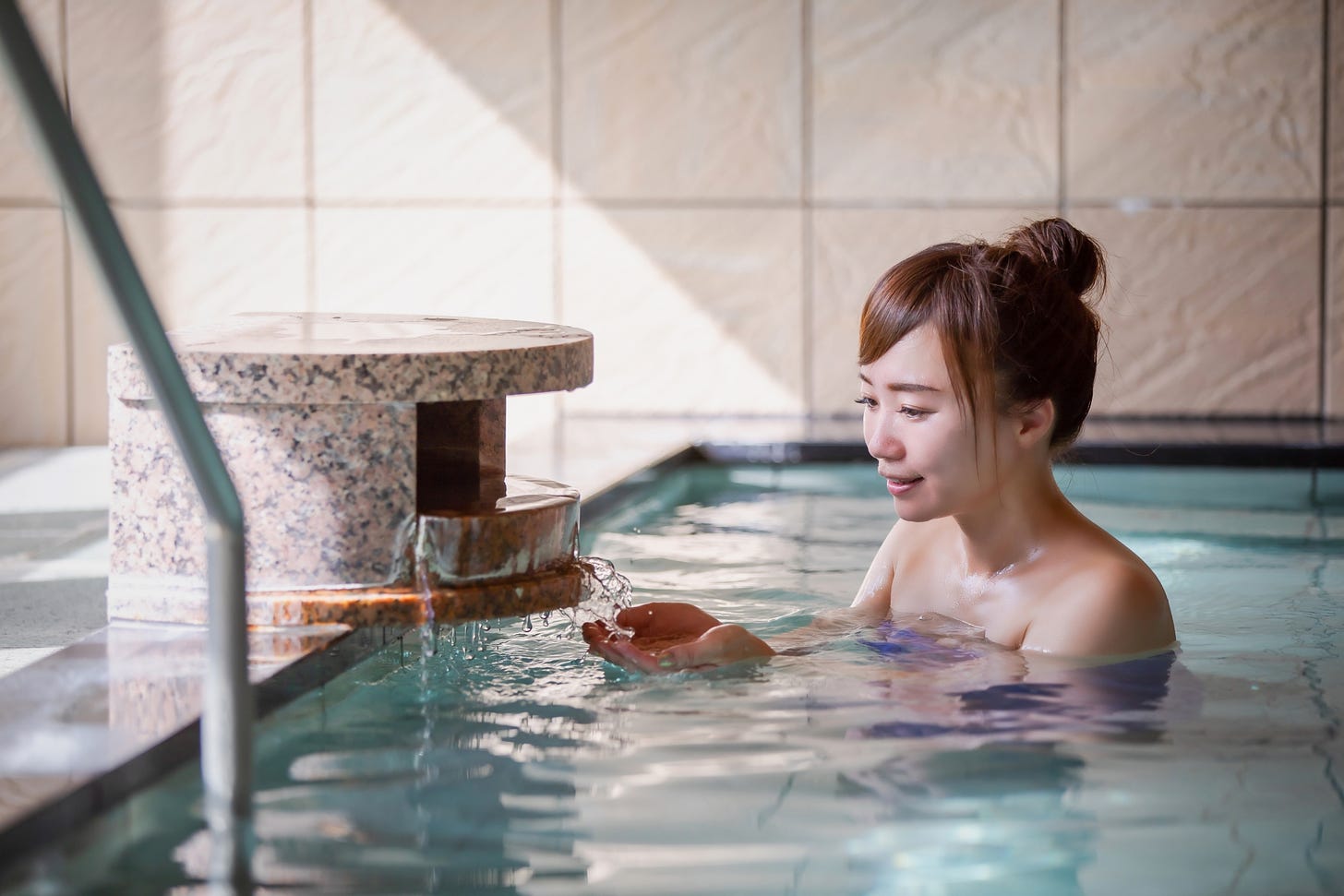
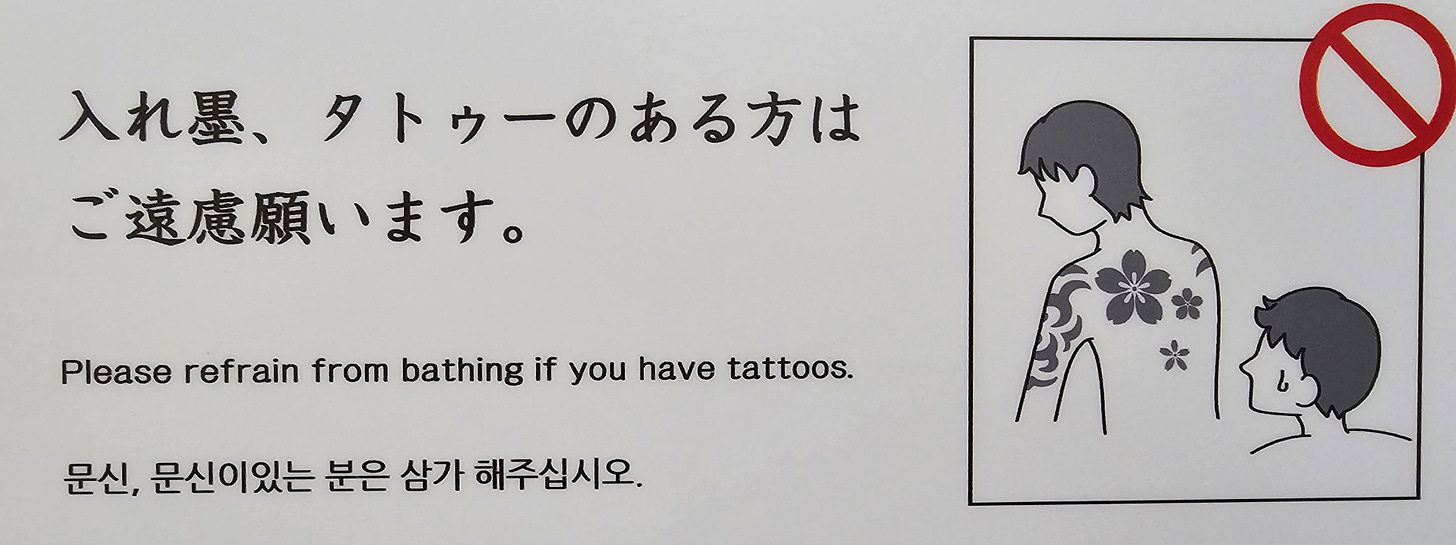
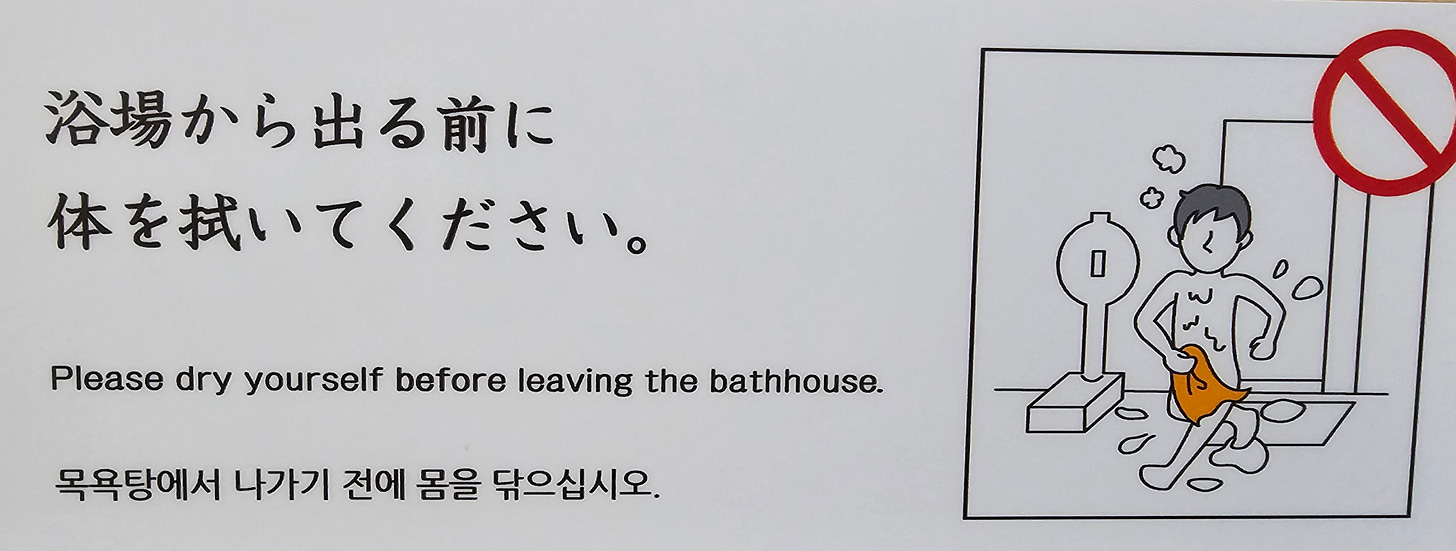
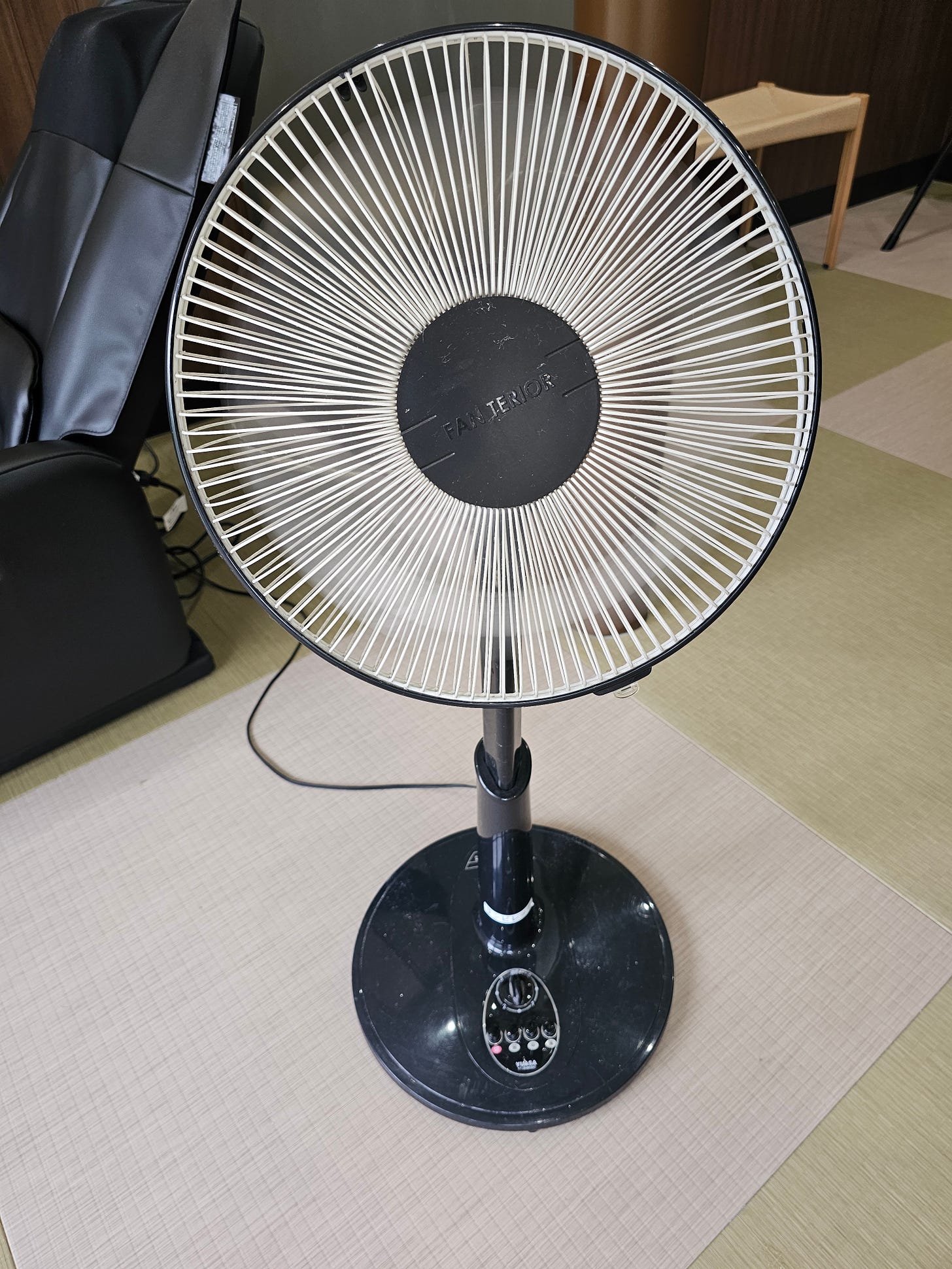
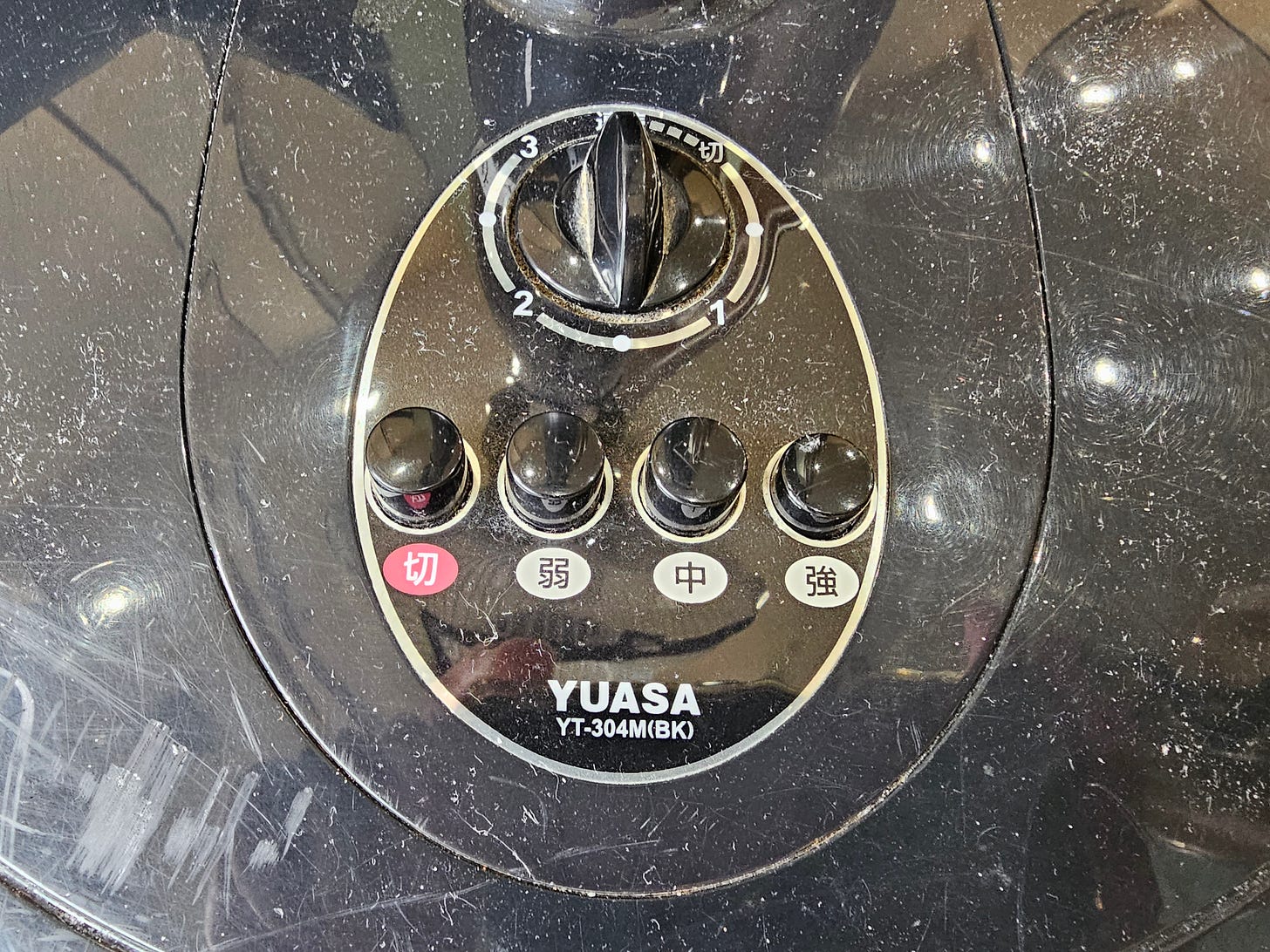
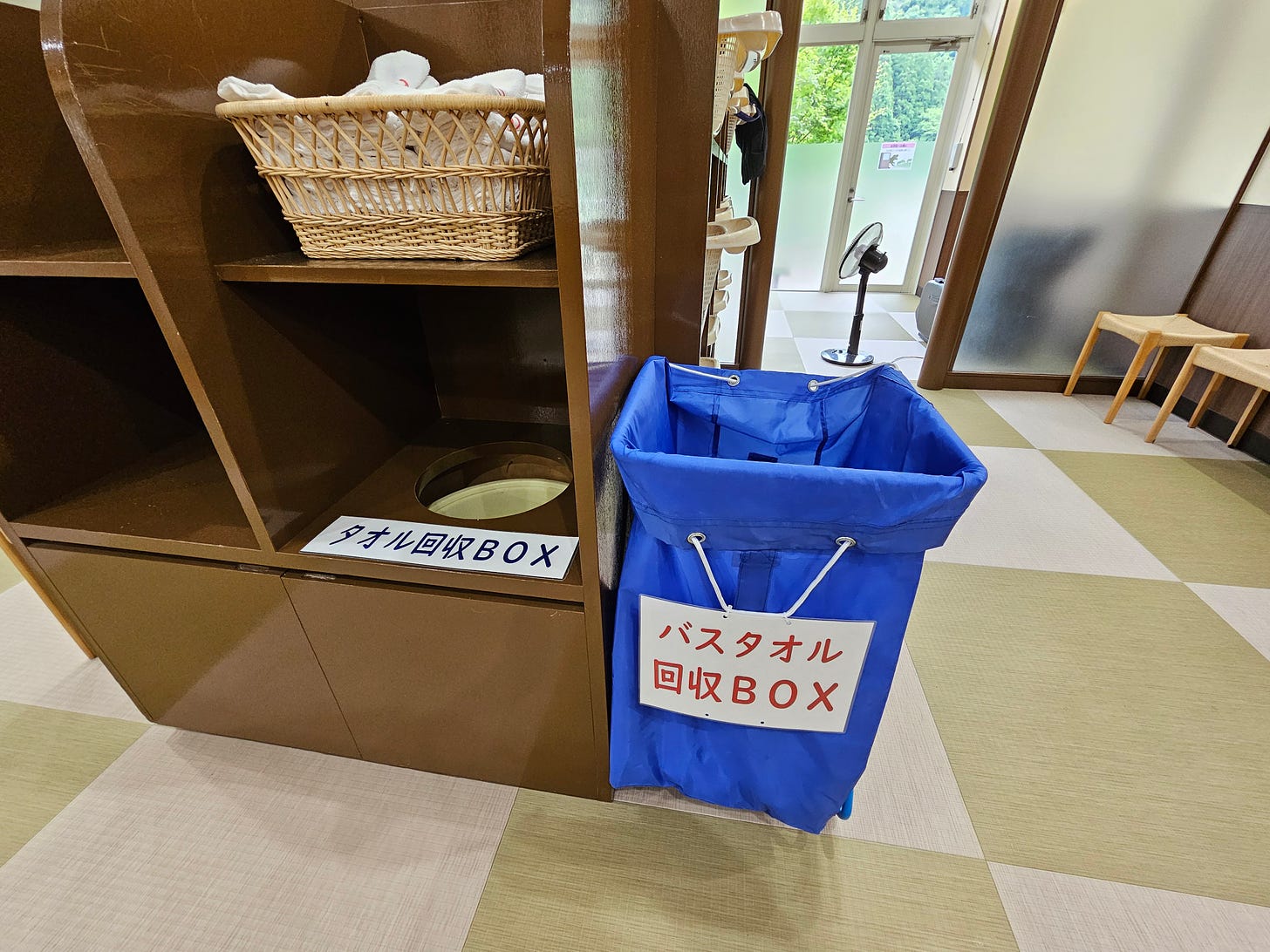
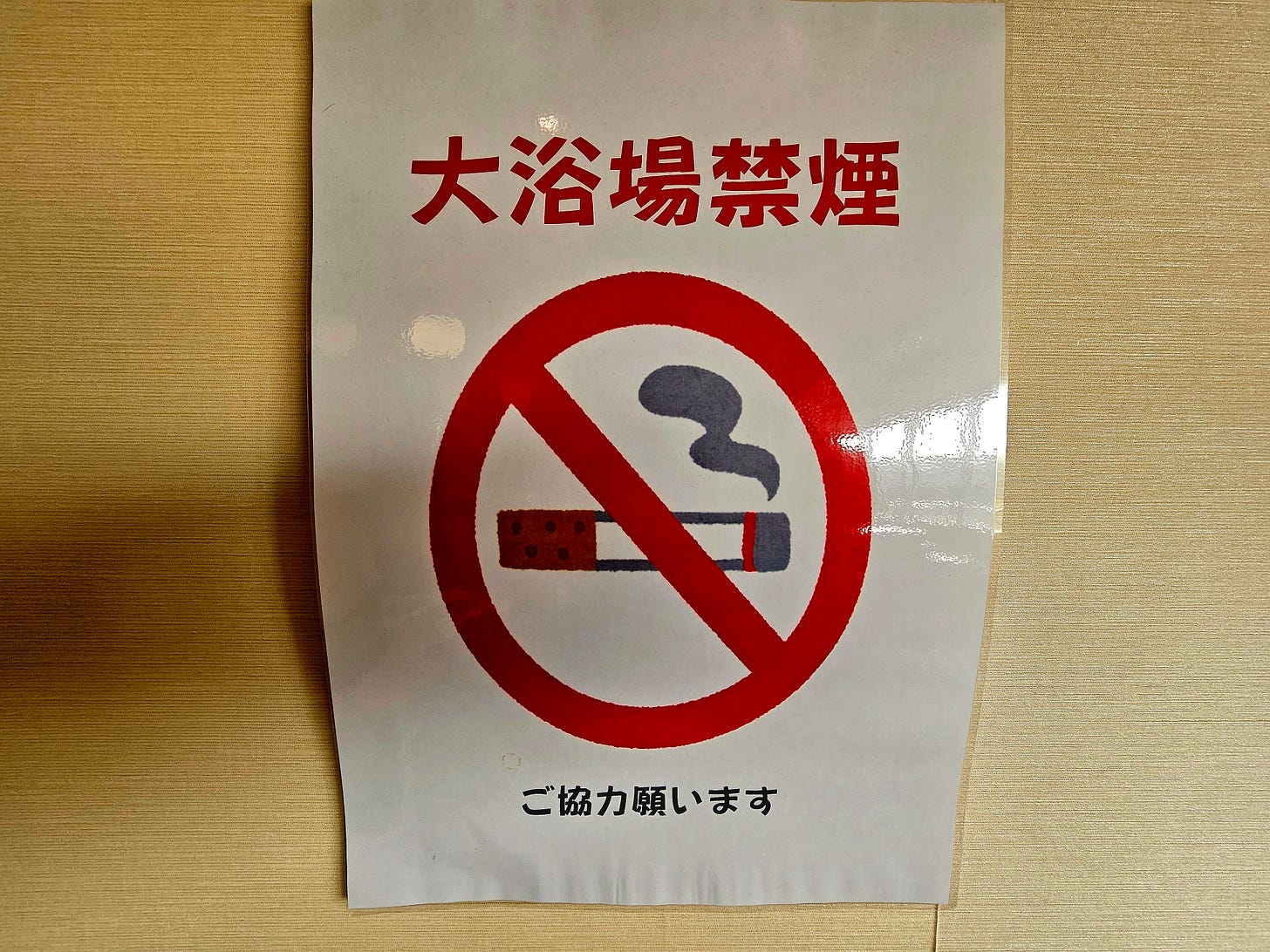
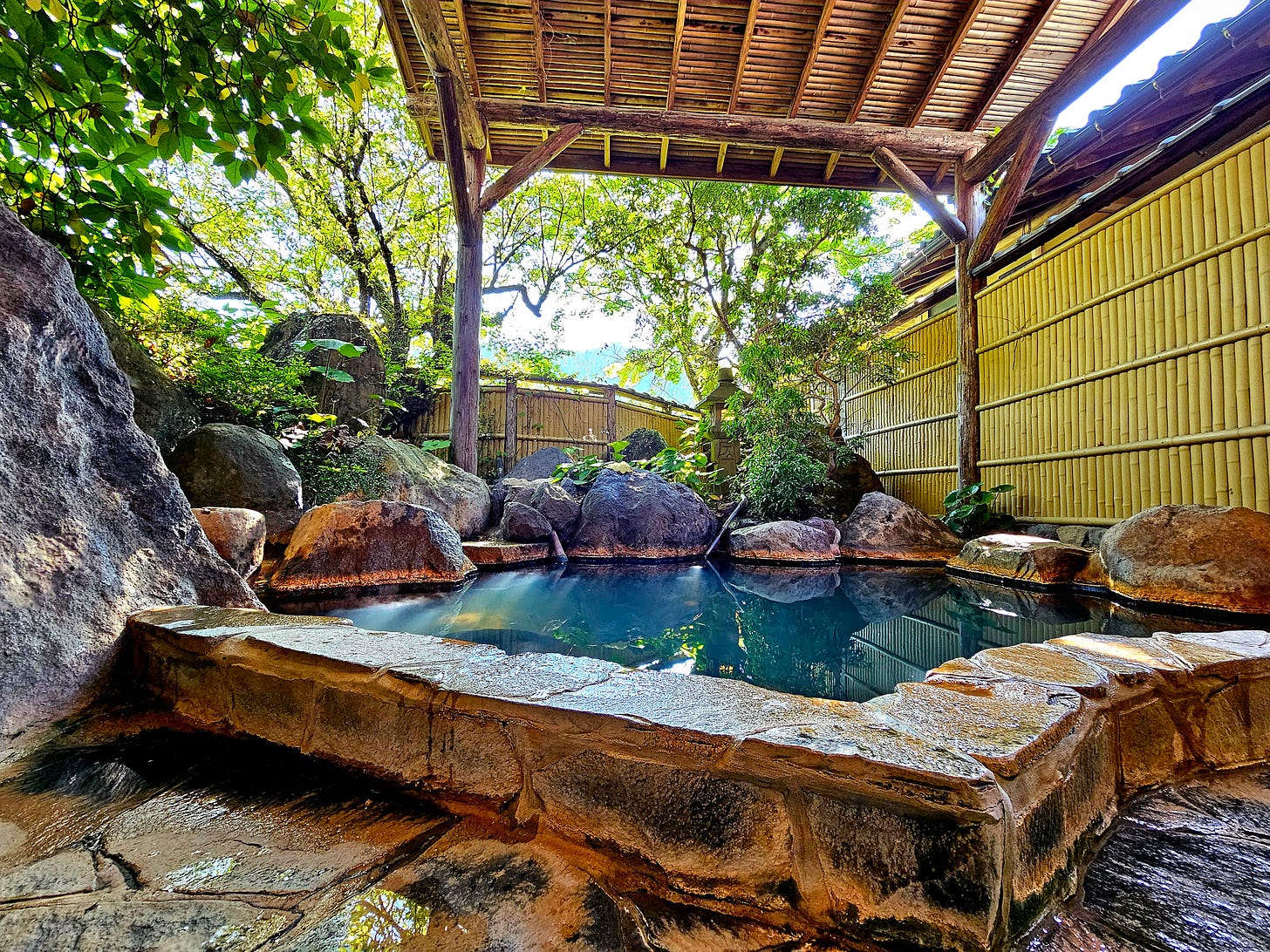
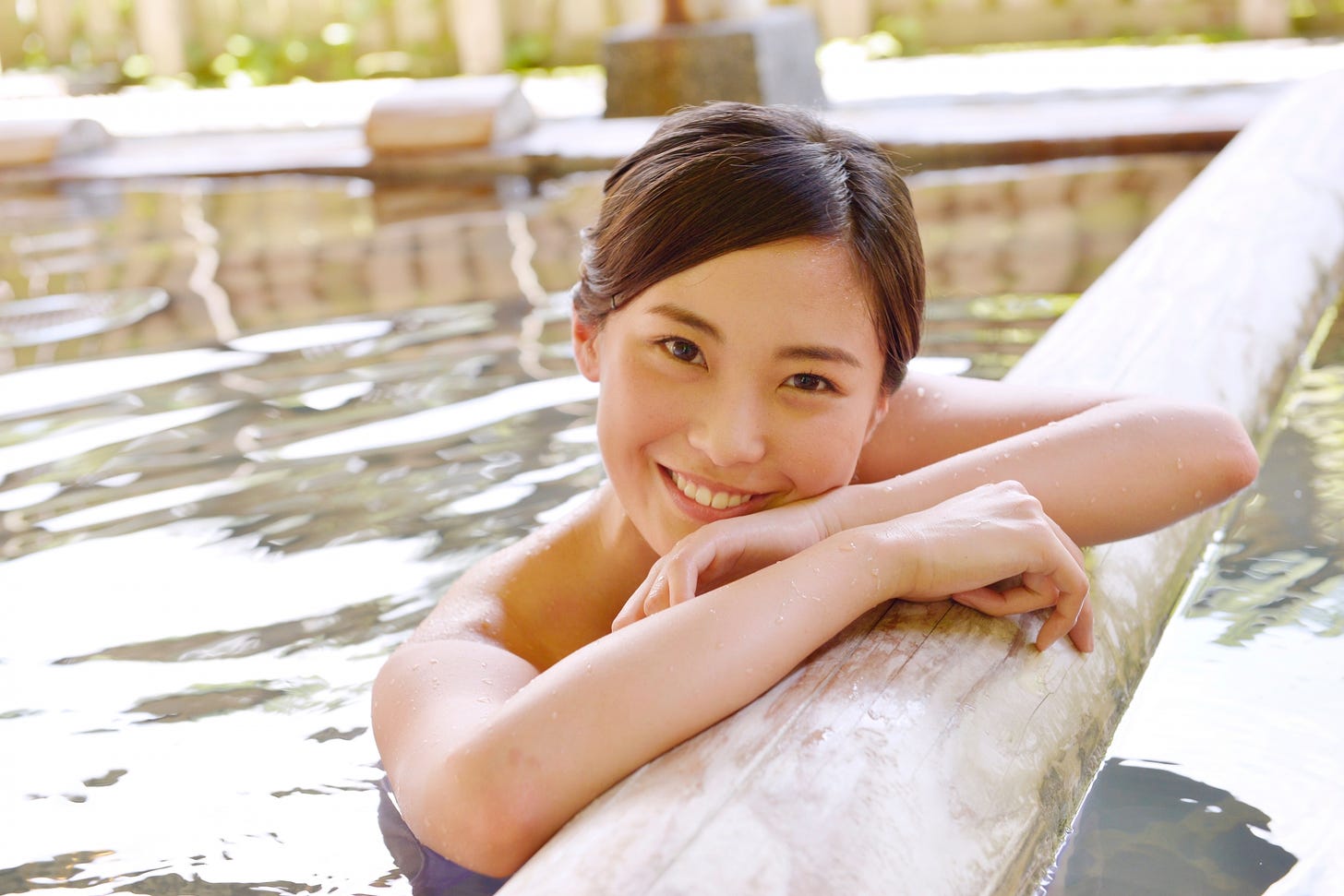
















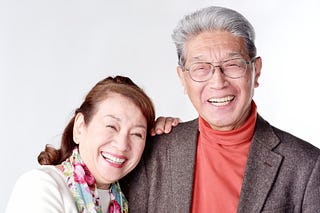
While visiting another onsen yesterday and taking a closer look at the signs, I realized that there are a few more useful words to add to your hot spring vocabulary.
Kakeyu (掛け湯): This means to wash your body with hot water before getting into the bath. The poster I found equates this practice to "warming up" for a hot spring -- literally. The idea is to use a small bucket to scoop up some hot water from the bathtub and then pour it over your body while standing or squatting at the edge of the tub. Don't let any of the water you pour over your body run back into the tub.
Hanshin-yoku (半身浴): When you enter the hot water, at first it is usually a good idea to get used to the temperature by soaking only the lower half of your body up to your waist. Hanshin (半身) means half body, and yoku (浴) means bathing. This approach is especially effective for those with weak hearts and/or difficulty breathing. Relax and remain calm as you adapt to the hot water.
Zenshin-yoku (全身浴): This term refers to a full-body, deep immersion soak. Zenshin (全身) means full body, and yoku (浴) means bathing. You can rest your head on the edge of the tub and let your body float to feel the buoyancy. Also, moving your hands and feet in the water helps to improve blood circulation.
The onsens should upgrade their signage to more humorous, like the Tokyo Metro did. https://www.telegraph.co.uk/news/picturegalleries/howaboutthat/3130032/Tokyo-Metro-signs-subway-etiquette.html%20target=